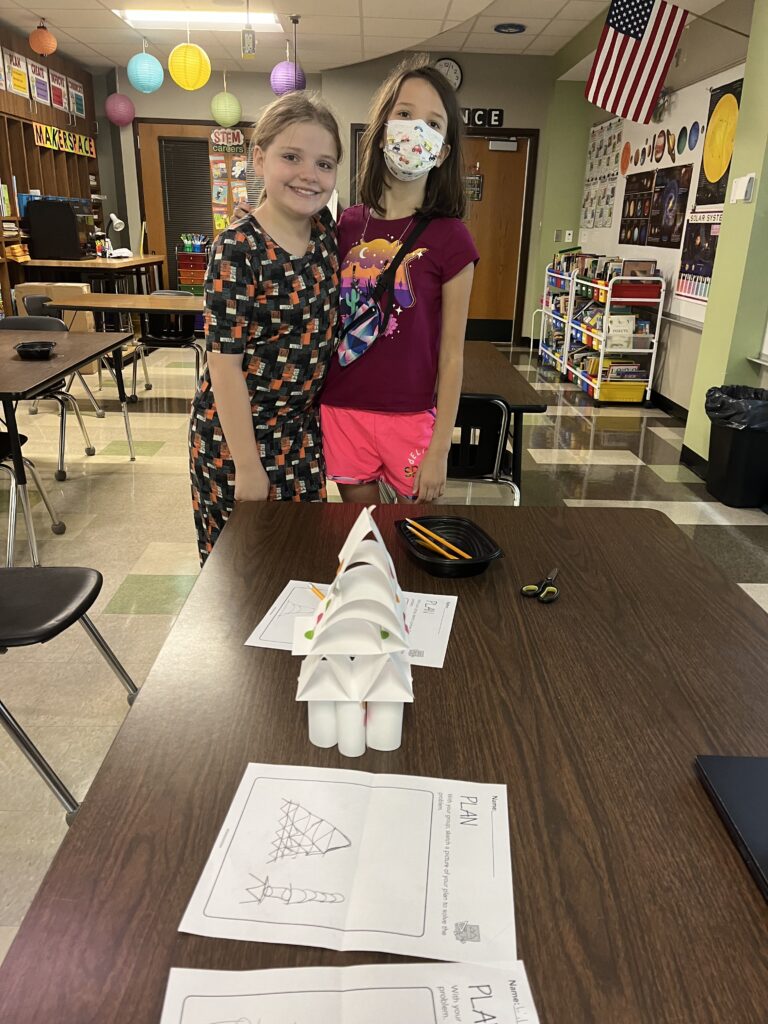Weekly STEM Blog

December 5th 2025
Scientist of the Week: Cason Burke

This week in science…
Fourth grade students made observations of external and internal parts of trees in order to collect evidence that these structures work together as a system to help plants survive in a particular environment. In the activity, Tree Detective, students used models of roots and branches to explore their functions and then constructed an argument about how these structures must work together in order to support the survival of trees in the unique environment of the frozen taiga.
Third grade students explored seasonal weather conditions across different regions. They investigated how weather patterns can be used to make predictions about future weather. In the activity, Snow Fort Weather, students organized daily temperature data from three snowy towns into a table so that they could compare weather conditions and predict which town is most likely to have the best weather for a snow fort festival next year.
First grade students read along with a story about a day at the beach. In this Read-Along lesson, Jada explores why her shadow changes over the course of a day at the beach. The lesson included a short exercise where students acted out the movement of shadows with their bodies.
Kindergarten students observed and described the weather, paying attention to the sun, the temperature, the wind, and precipitation.







November 21st, 2025
Scientist of the Week: Cason Burke

This week in science…
Fourth grade students made observations of external and internal parts of trees in order to collect evidence that these structures work together as a system to help plants survive in a particular environment. In the activity, Tree Detective, students used models of roots and branches to explore their functions and then constructed an argument about how these structures must work together in order to support the survival of trees in the unique environment of the frozen taiga.
Third grade students explored seasonal weather conditions across different regions. They investigated how weather patterns can be used to make predictions about future weather. In the activity, Snow Fort Weather, students organized daily temperature data from three snowy towns into a table so that they could compare weather conditions and predict which town is most likely to have the best weather for a snow fort festival next year.
First grade students read along with a story about a day at the beach. In this Read-Along lesson, Jada explores why her shadow changes over the course of a day at the beach. The lesson included a short exercise where students acted out the movement of shadows with their bodies.
Kindergarten students observed and described the weather, paying attention to the sun, the temperature, the wind, and precipitation.
November 14th, 2025
Scientist of the Week: Harper Riggen

This week in Science…
Fifth grade students each researched a different invasive species and completed a research packet. Then they made a “Most Wanted Poster” on google slides and presented their poster to the class. They were very creative and had fun presenting to the class!
Fourth grade students explored how animals receive information through their senses and process that information in their brain, using instincts and memories to guide their behaviors. In the activity, Raccoon Reactions, students used models to understand how an animal’s senses, brain, and memories all work together as a system to influence their behavior and support their survival.
Third grade students learned how to make predictions about the weather by observing clouds and their changes. In the activity, Storm Spotter’s Guide, students created a small book to record their notes, identify different types of clouds, and think about wind direction to figure out if a storm is heading their way.
Second grade students developed a model of the earth’s surface and used it to discover an important principle about how rivers work. In the activity, Paper Mountains, students took turns using a spray bottle to make rain fall on paper models of mountains to observe patterns of how water and rivers flow.
First grade investigated what it takes to make a stationary object’s shadow move. In the activity, Moving Shadows, students used flashlights and paper gnomes to explore how moving the position of a light makes shadows move. Students relate these observations to shadows changing throughout the day and the Sun’s position moving across the sky.
Kindergarten students observed changes in the weather when a storm is coming. In the activity, Breeze Buddy, students made a simple tool that lets them see how windy it is.


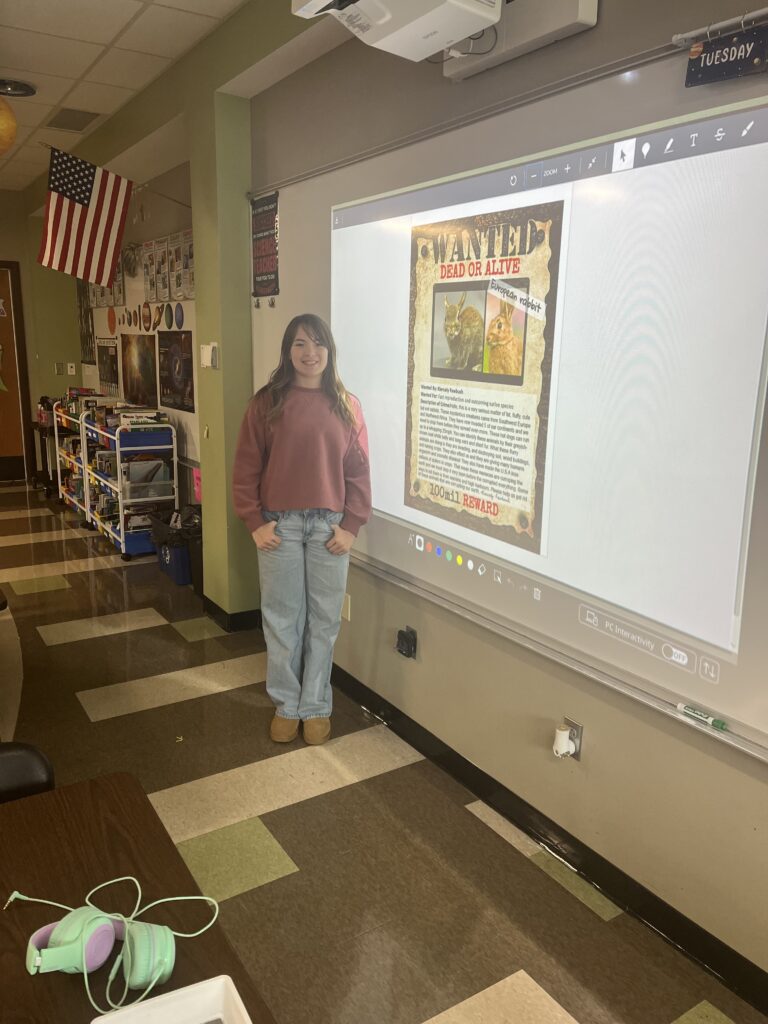
November 7th, 2025
Scientist of the Week: Jennifer Burt

This week in Science…
Fourth grade students explored how animals receive information through their senses and process that information in their brain, using instincts and memories to guide their behaviors. In the activity, Raccoon Reactions, students used models to understand how an animal’s senses, brain, and memories all work together as a system to influence their behavior and support their survival.
Third grade students learned how to make predictions about the weather by observing clouds and their changes. In the activity, Storm Spotter’s Guide, students created a small book to record their notes, identify different types of clouds, and think about wind direction to figure out if a storm is heading their way.
Second grade students developed a model of the earth’s surface and used it to discover an important principle about how rivers work. In the activity, Paper Mountains, students took turns using a spray bottle to make rain fall on paper models of mountains to observe patterns of how water and rivers flow.
First grade students began a new science unit about the sun and the shadows it makes. In this unit, students make observations of the Sun and shadows throughout the day and across the seasons. They use their observations to understand patterns that occur throughout the day.
Kindergarten had a read-along lesson. Students listened to an illustrated digital storybook with student participation. In the story, JJ and his grandfather get ready for a big thunderstorm. In the activity, Get Ready for a Storm, students learned about other kinds of storms and acted out ways to prepare for storms.



October 31, 2025
Scientist of the Week: Chase Knight

This week in science…
Fifth grade began the Invention Convention this week. Chelsea Busby from the Purdue Extension office came to Helmsburg and introduced our fifth graders to what Invention Convention is and talked about the difference between an invention and innovation. The students also played an Invention Madness game to determine the most important modern day invention.
Fourth grade students made observations of an underwater animal, a frogfish, in order to collect evidence that its external structures serve specific functions. In the activity, Frogfish Finder, students used their observations to construct an argument that the frogfish’s external and internal structures work together as part of a system to support their growth and survival.
Third grade students examined clues about how clouds look and feel to discover what they’re made of and how they form. In the activity, Gas Trap, students added hot water to clear cups to observe evaporation firsthand. They observed the condensation of the water vapor on the sides of the cup. They used this model to understand how clouds are formed.
Second grade students explored maps as useful tools for understanding where landforms and bodies of water are located. In the activity, Mystery Mapmaker, students identified different land and water features based on their shapes. Then, they used those landmarks to complete a map and locate a treasure of their very own.





October 24, 2025
Science Student of the Week: Leanora Gordon

This week in science…
Fifth grade students are wrapping up their Web of Life Unit with a final task. For the final task, students evaluated a list of proposed organisms for a Mars habitat. They then wrote an argument for or against the proposal as a good ecosystem. After evaluating their proposal, students made recommendations on how to improve the ecosystem.
Fourth grade students began a new unit all about Animal and Plant Adaptations. In this unit, students explore the adaptations of animals and plants. Students investigate how the external and internal structures of an organism work together as an interconnected system that aids in their growth and survival. They also use models to explore how a combination of instincts and memories influence animal behavior.
Third grade students began a new unit called Stormy Skies. In this unit, students investigate and make predictions about the weather through careful observation of the clouds and wind. Students also learn to differentiate between weather and climate and use models to reveal global climate patterns.
Second grade students began a new unit called Work of Water. In this unit, students explore how water shapes the Earth’s surface. Students construct and use models of mountains to demonstrate that water flows downhill, and in the process, transforms huge rocks into the tiny grains of sand we find at the beach. Students also construct and use model hills to determine the causes of erosion, and to design solutions to problems caused by erosion.








October 6, 2025
Scientist of the Week: Liliana Owens

This week in Science…
Fifth grade students investigated the hypothesis that an asteroid impact caused the extinction of the dinosaurs. In the activity, Create a Dinosaur Food Web, students used cards and construction paper connectors to create a food web from the time of the dinosaurs. Using this model, they followed the flow of energy through the food web and figured out why dinosaurs went extinct but some other animals survived.
Third grade students learned how to use TinkerCad. TinkerCad is an application for 3D design, electronics simulation, and code-based block coding. This is an excellent tool for beginners to learn 3D modeling for purposes like 3D printing. Students can also explore circuitry and create animations through code blocks.
First grade students discovered how butterflies’ colors can help them blend into their habitat or scare away predators. In the activity, Paper Butterflies, students designed their own paper butterflies by choosing colors that will help the butterflies survive, then create a butterfly card for someone special.


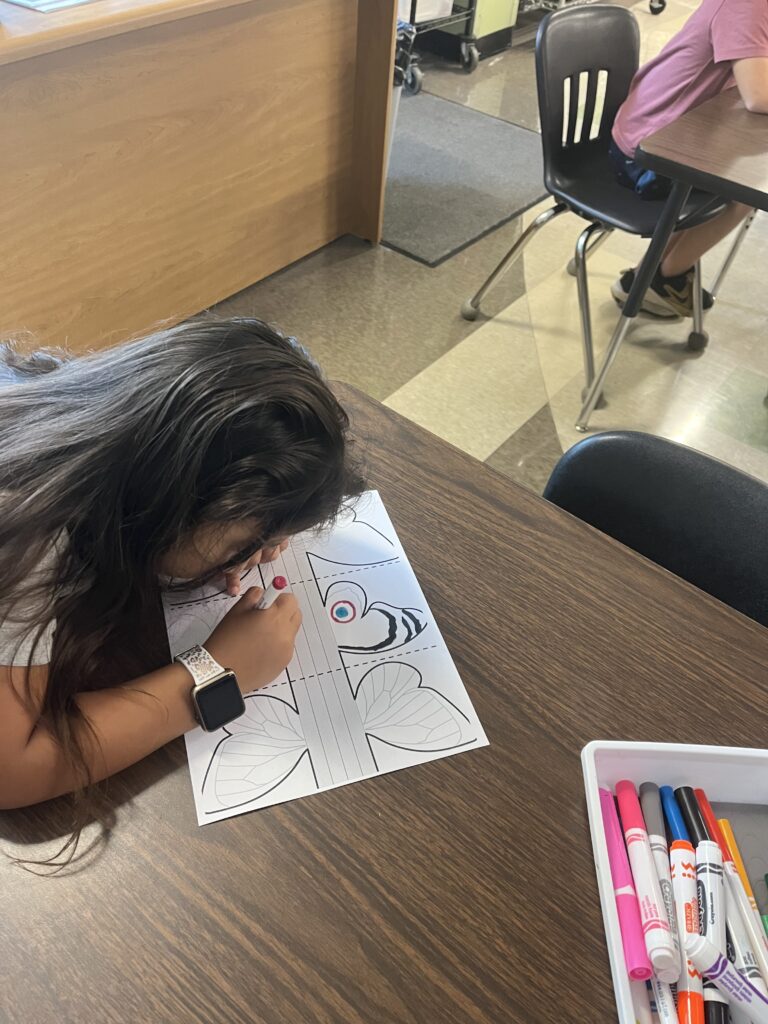



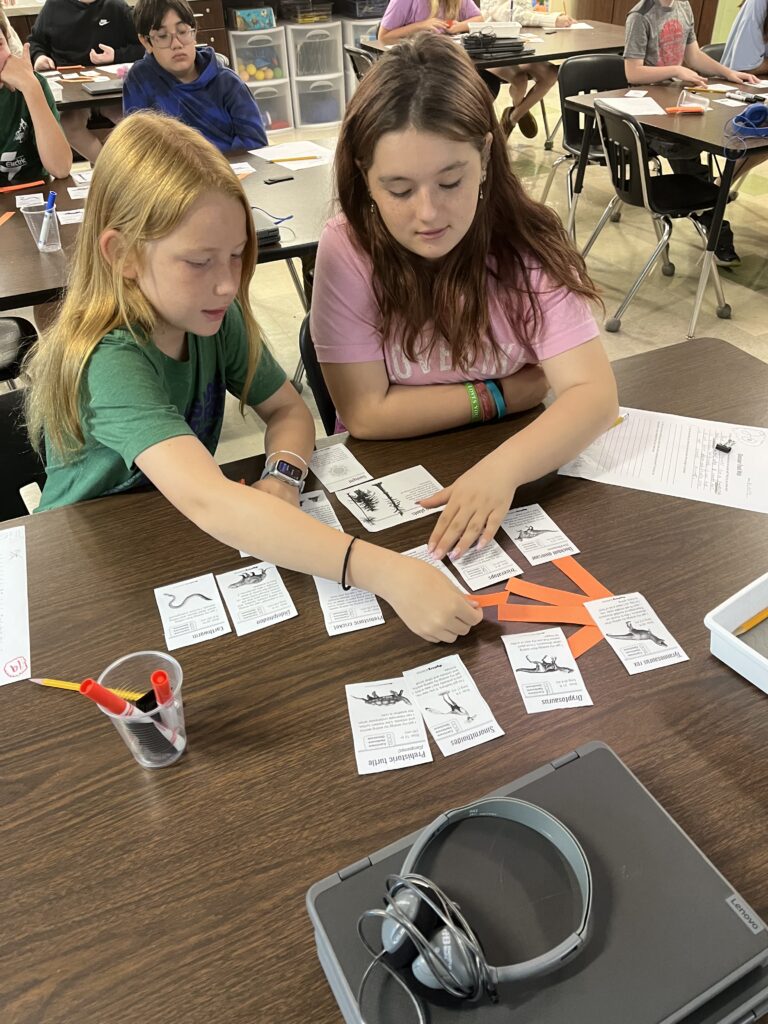

October 3, 2025
Scientist of the Week: Bryson Hedger

This week in science…
Fifth grade students learned about a very interesting area outside of New York City called The Meadowlands. Students then designed their own version of the Meadowlands using TinkerCAD. Students had to include details from the article in their designs.
Fourth grade students have been working on Human Body Systems. Each student chose a body system and made a 3-D model of the body system and the vital parts using TinkerCad. Students had to label the parts of the system as well.
Third grade students learned about different science careers this week. Students picked one field of science and researched what that type of scientist does, where they work, why their work is important and any kind of training or education they might need to perform their job.
Second grade students finished their Animal Adventures unit by learning about the Mexican Free-Tailed Bat and the two very different habitats they can be found in.
First grade students made observations to construct an explanation of why camouflage is helpful to animals. In the activity, Moth Hide and Seek, students tested their ability to spot camouflage moths, and then designed a camouflage pattern for a moth of their own and hid it in the classroom!
Kindergarten students participated in a Read-Along lesson. In the read aloud, Desiree notices all the holes in the trees around her house—and sets out to discover how they got there, and why they matter. The lesson included a short exercise where students listened for animal sounds and pretended to be woodpeckers.


September 26, 2025
Scientist of the Week: Ivory Workman

This week in science…
Fifth grade students combined what they have learned about plants, animals, and decomposers to see how they interact in an ecosystem. In the activity, Pond Ecosystem Game, students first build a pond ecosystem that supports a sunfish. To succeed, they must make sure that carbon dioxide levels are healthy for both plants and animals. Then, students played a game called Big Fish where they Second grade students investigated which kinds of birds are likely to visit a bird feeder based on what they eat. In the activity, Design a Bird Feeder, students first drew their own bird feeder design to attract a specific type of bird. Then they built a prototype of their bird feeder using available materials.
Second grade students investigated which kinds of birds are likely to visit a bird feeder based on what they eat. In the activity, Design a Bird Feeder, students first drew their own bird feeder design to attract a specific type of bird. Then they built a prototype of their bird feeder using available materials.
First grade students carried out an investigation to determine the relationship between the shape of different bird beaks and the food each bird eats. In the activity, Find the Best Beak, students experimented with long pointy beaks that are great for picking up seeds and wide flat beaks that are good for scooping. They discovered that different beaks are best for different kinds of food.
Kindergarten students observed different animal behaviors and worked to discover another pattern: all animals seek safety in order to survive. The activity, Gopher in a Hole, included physical movements in which students pretended to be snails hiding in their shells, praying mantises scaring away predators, and gophers popping out of holes.competed to make a healthy ecosystem for a sunfish.





September 19, 2025
Scientist of the Week: Finley McFall

This week in science…
Fifth grade students developed a model to describe the flow of matter between living things and the environment, with an emphasis on decomposers. In the activity, Decomposer Detectives, students gathered information from suspects on the forest floor, and modeled the decomposition process of fallen leaves in order to solve the mystery of why those leaf piles seemed to disappear.
Fourth grade students researched an animal or plant. They created a system model to explain how the animal’s or plant’s parts work together as a system to receive information, process it, and respond to its environment.
Third grade students learned about how fossil dinosaur tracks reveal how quickly a dinosaur was running. In the activity, Outrunning CeeLo, students figured out if they could have won a race with a dinosaur that was just their size. To determine the winner, students compared the length of their running steps with the dinosaur’s steps.
Second grade students learned about a case study in biodiversity using the frogs of North America. In the activity, Who’s Calling?, students learned to identify frogs by their unique calls and investigated which of two locations has a greater variety of frogs. After listening to recordings of frog calls, students created words that reminded them of the sounds, and then used those words to identify frog sounds in different environments.
First grade students participated in a Read-Along lesson and learned about Juan Carlos when he visits his grandmother who has a backyard full of ducks. The lesson included a short exercise where students got moving by acting like ducks.
Kindergarten students participated in a Read-Along lesson. In the story, Sofia wonders where animals live and goes for a walk in the woods to find out. The lesson included a short exercise where students pretended to be squirrels and learned about their habitats.






September 12, 2025
Scientist of the Week: Maverick Kolacz

This week in science…
Fifth grade students discovered how it is possible for plants to grow and gain tremendous amounts of weight without eating anything. In the activity, Plant Matter Mystery, students gathered evidence from a series of virtual experiments related to plant growth. Then, they used that evidence to create an argument that plants get matter they need for growth chiefly from air and water.
Fourth grade students explored the brain’s role in receiving information from the senses, processing that information, and controlling the muscles to enable movement. In the activity, Think Fast!, students tested their reflexes with two very quick experiments and one more involved activity. They learned how we process information in our brains and then respond to that information in different ways.
Third grade students analyzed data from dinosaur fossils in order to provide evidence about the appearance and behavior of those dinosaurs when they were living. In the activity, Dinosaur Detectives, students compared the traits of dinosaur fossils with the traits of modern animals in order to help a paleoartist draw a dinosaur as accurately as possible.
Second grade students solved the mystery of why a group of wild bighorn sheep would leave their usual desert habitat to visit a second, very different habitat: a local playground. In the activity, Habitat Scavenger Hunt, students recorded observations of the diversity of life found in the desert and the playground, as well as the physical characteristics of each location. Students combined these observations to create an understanding of how the living and non-living parts of a habitat support the animals that live there.
First grade students gathered evidence that animal offspring look like, but not exactly like, their parents. In the activity, Possible Puppies, students played a game that models how puppies look similar to their parents, but each puppy can vary in many ways.
Kindergarten students observed animal behaviors and worked to discover a pattern: all animals seek food in order to survive. The activity, Eat Like an Animal, includes physical movement in which students acted out animal behaviors, pretending to be quail scratching in the dirt, raccoons wading in the water, and woodpeckers pecking a log.






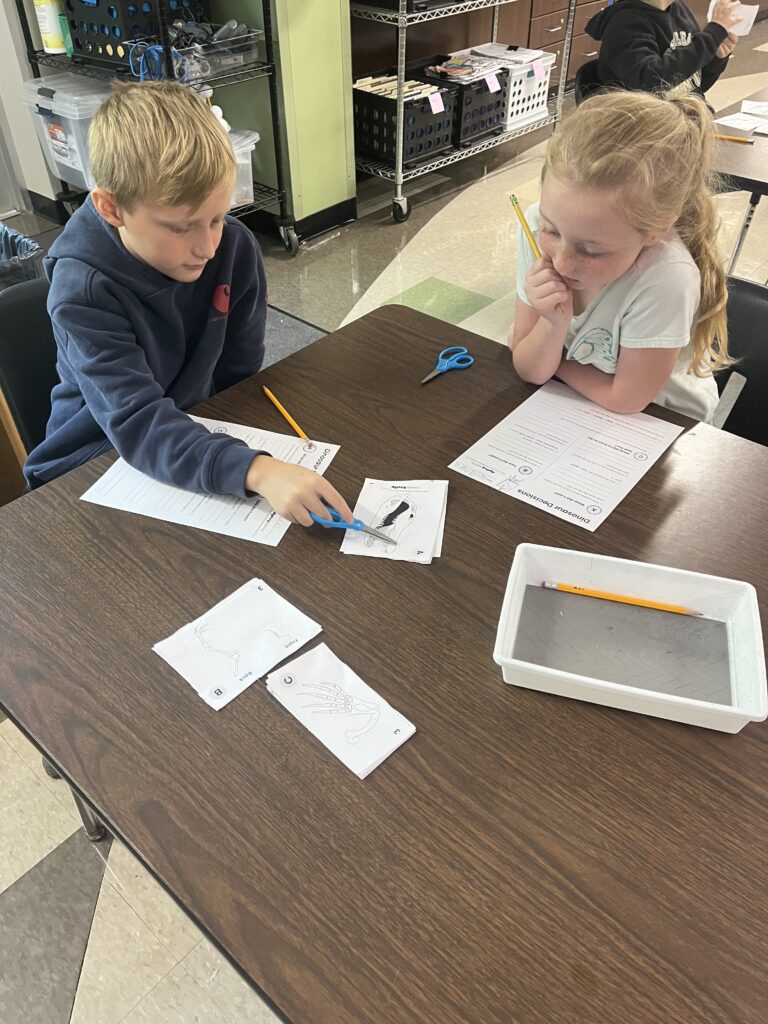
September 5, 2025
STEM Student of the Week: Ranger Hall

This week in science…
Fifth grade students developed their thinking about the predator/prey relationships between living things. In the activity, Eat or Be Eaten, students played a card game in which they made food chains with predators and prey, and producers and consumers. The students who made the longest food chains won the game!
Fourth grade students delve further into the workings of the eye, exploring the function of their iris and pupil. In the activity, Pupil Card, students added a smaller pupil to the eye model that they created in the previous lesson. Then they observed how the changing size of the pupil controls how much light enters the eye.
Third grade students explored the idea that the rock under our feet sometimes contains fossils, and investigated how these fossils reveal changes in habitats through time. In the activity, Fossil Dig, students used paper to create a model fossil dig. They identified traits of fossils to determine what the habitat looked like when these organisms were alive. Then they used this information to figure out where some Mystery Fossils belonged in their fossil dig.
Second grade students examined how scientists organize animals into groups based on their characteristics. In the activity, Animals Sorting Game, students studied animal traits and used these traits to sort animal cards into mammals, birds, reptiles, and invertebrates. Students were then challenged to make decisions about animals that don’t fall neatly into any of those categories.
First grade students made observations of baby animals and their parents, gathering evidence that they look similar because they share many of the same traits. In the activity, Baby Bird Rescue, students helped identify lost baby birds based on observations of their specific traits.
Kindergarten students began a new science unit called Animal Secrets. In this unit, students use observations to understand the basic needs of animals. Students explore how animals need things to eat and a safe place to live, and also how animals can change their environments to meet those needs.



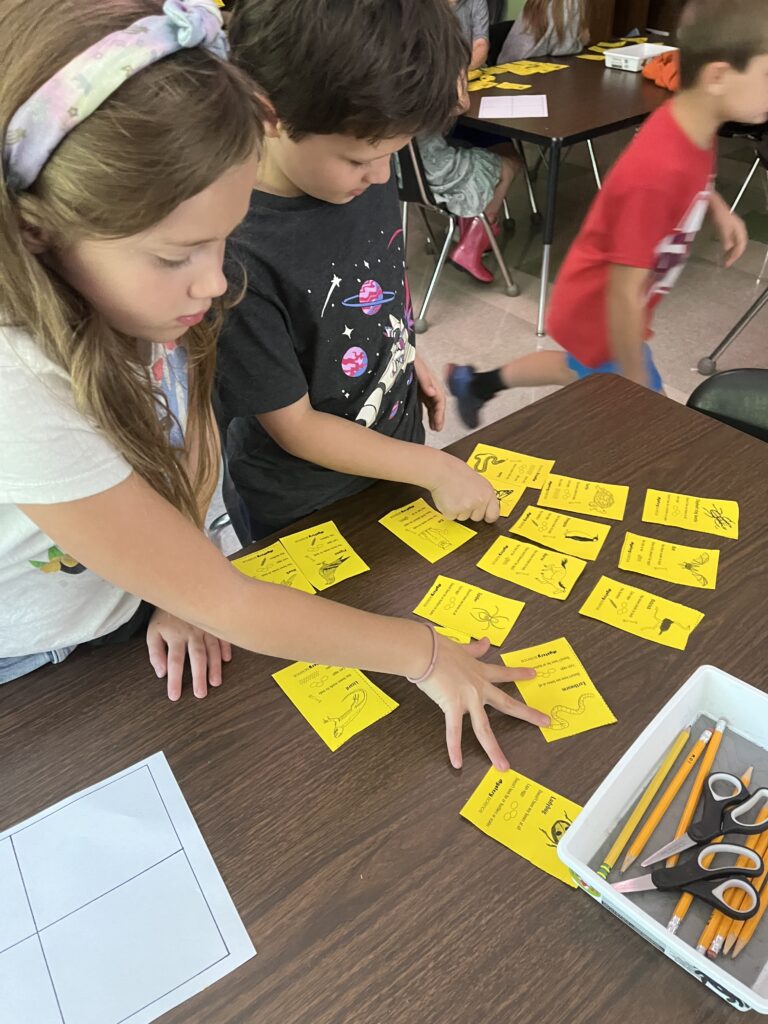

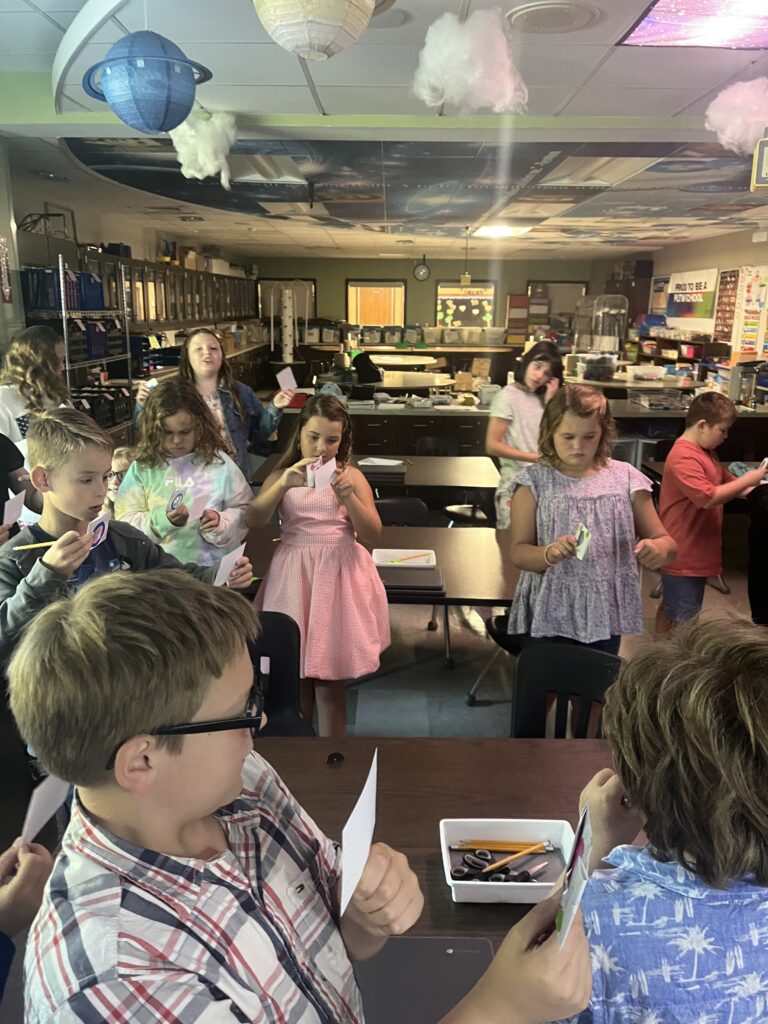
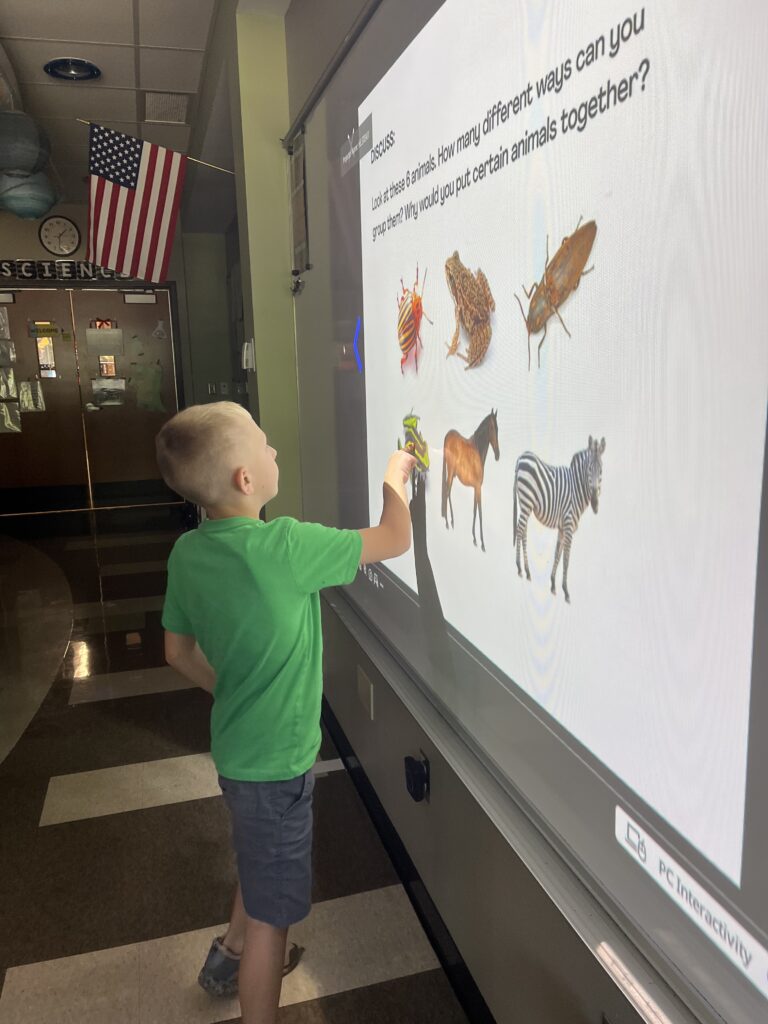







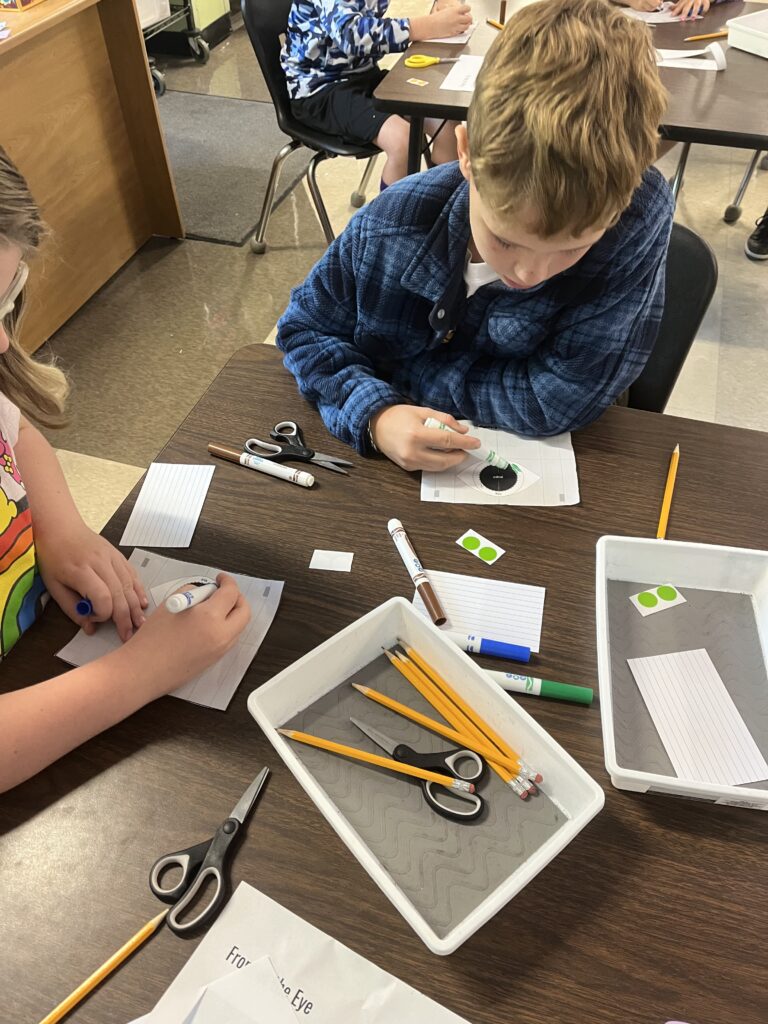
August 29, 2025
Science Student of the Week: Eva Martin

This week in Science…
Fifth grade students began a new science unit called Web of Life. In this unit, students explore how organisms depend on one another and form an interconnected ecosystem. Students investigate food chains, food webs, and the importance of producers, consumers, and decomposers.
Fourth grade students began a new science unit called Human Machine. In this unit, students investigate structures and functions of the human body. Students explore how our bones and muscles are interconnected, how our eyes interact with light and impact our vision, and how our brain responds to stimuli in our environment.
Third Grade students began a new science unit called Animals Through Time. In this unit, students develop an understanding of how animals and their environments have changed through time. Fossils provide a window into the animals and habitats of the past. Analyzing the traits of animals that are alive today and comparing them to fossils, provides evidence of how these ancient organisms and environments of the past may have appeared.
Second grade students began a new science unit called Animal Adventures. In this unit, students begin to develop an understanding of the world’s animal biodiversity. They explore animal classification and the traits that define each group. Students then turn their focus to habitats and how the surrounding environment affects what organisms live in a particular environment.
First grade students began a new science unit called Animal Superpowers. In this unit, students explore how the external characteristics of animals are essential for their survival. Students also make observations of parents and their offspring, determining how they are similar and how their behaviors help offspring survive.
Kindergarten students began a new science unit called Animal Secrets. In this unit, students use observations to understand the basic needs of animals. Students explore how animals need things to eat and a safe place to live, and also how animals can change their environments to meet those needs.
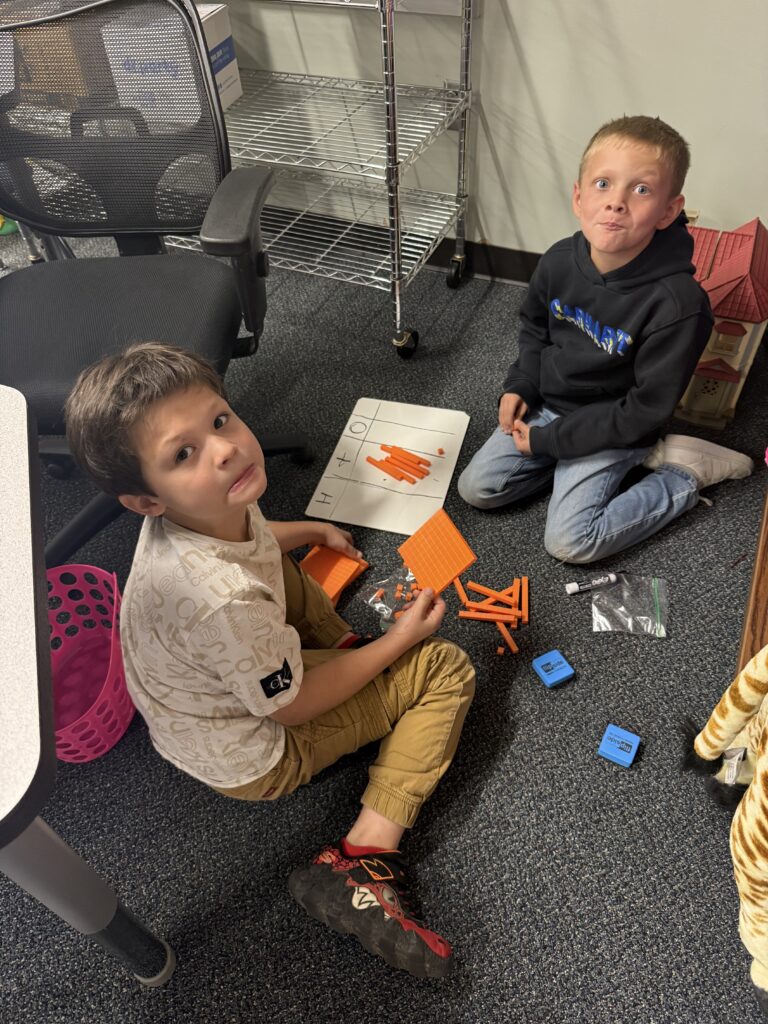


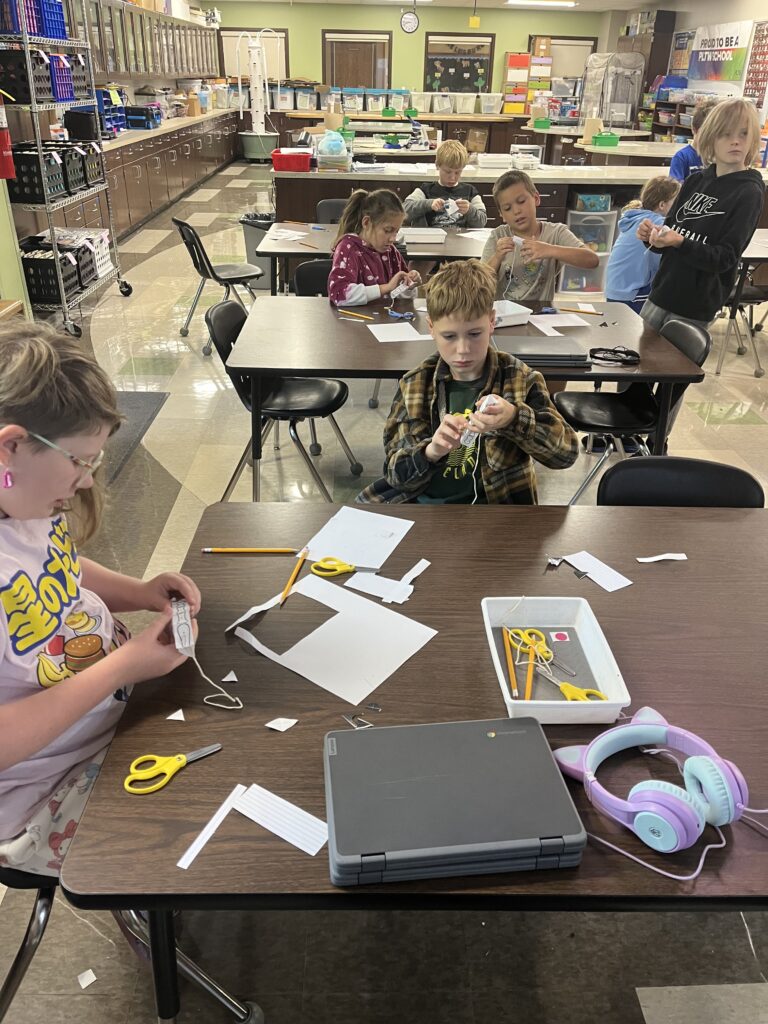


August 22, 2025
STEM Student of the Week: Colton Stiles

This week in STEM…
Students in all grades learned what it means to persevere in science and that Tigers keep going no matter how hard it gets! Kindergarteners and first graders built lego bridges with a partner. They learned that even with limited time and materials, they can accomplish lots when they work together.
Third, fourth, and fifth graders reviewed the steps of The Scientific Method and Scientific Inquiry Process with candy labs. Fourth and fifth graders used the scientific method to find out if all colors are represented equally in a bag of m&m’s and third grade predicted the most prevalent color in a bag of skittles. And of course they got to eat their candy!








May 9, 2025
STEM Student of the Week: Jaylen Blevins

This week in STEM…
Students in grades 2-5 worked on STEM Bin rotations this week. Groups of 2-3 students worked to complete specific challenges at each station. Challenges included building platforms to support weight, solving pattern puzzles, building challenges, and completing pictures to represent different objects. Students in grades 4-5 also used our cardboard tools and their imagination to create everyday objects. Some of our 5th graders made a logo board. Very creative!






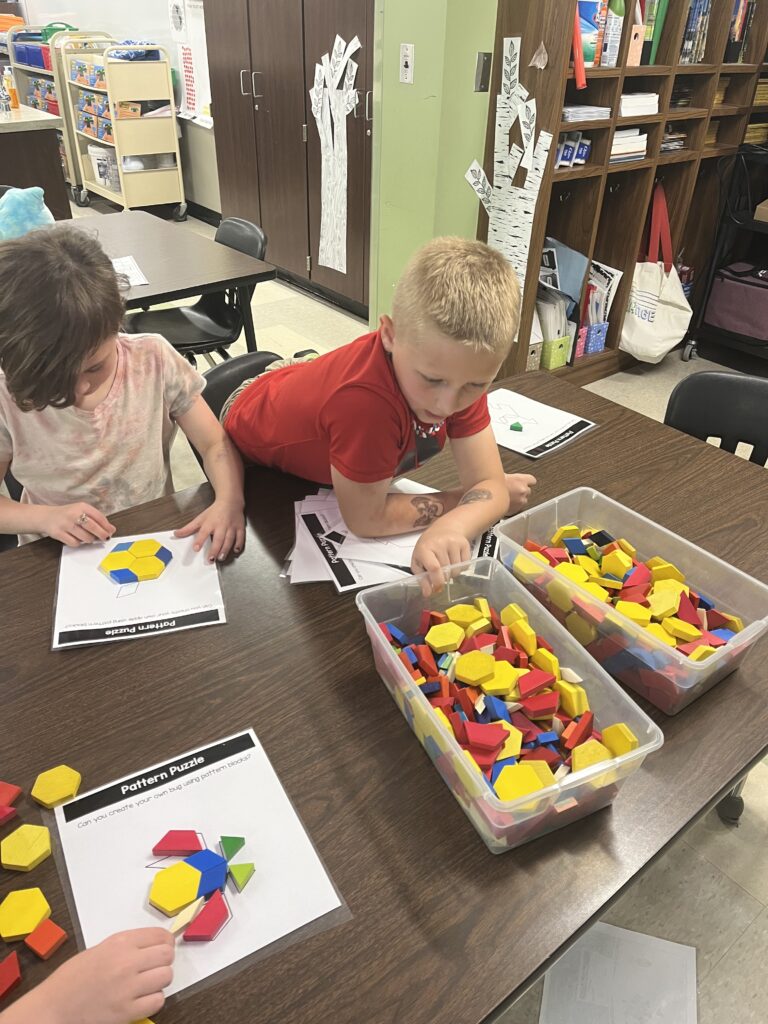
May 2, 2025
STEM Student of the Week: Graham McFall

This week in STEM…
Students in grades 3-5 participated in a STEM Challenge. The challenge was based on the book, One Plastic Bag. Students were given tape, scissors, markers, straws, and one plastic bag. Their challenge was to use the materials and repurpose the bag into something useful. This challenge required very thoughtful planning and they needed to use their materials wisely. Students could choose to work on their own or with a partner. We had some very successful designs!














April 25th, 2025
STEM Student of the Week: Lewis Doughty

This week in science we celebrated Earth Day! All students participated in an Earth Day themed lesson. Fifth graders solved the mystery of the missing recycling bins. They had to solve puzzles to determine who the culprit was. Fourth grade played a review Jeoparty game to prepare for their Science iLearn test. Third graders learned the difference between renewable resources and non-renewable resources. Second grade learned how they can do their part to take care of Earth. We talked about the three R’s and how students can reuse, reduce, and recycle at home and at school. First grade made star projectors using paper cups and flashlights. They poked holes on the bottom of the cup to make The Big Dipper. Kindergarten students learned about why we have Earth Day and how recycling works.







April 18th, 2025
STEM Student of the Month: Gabbie Calan-Bustamante

This week in STEM…
Fifth grade students constructed an explanation about a surprising phenomenon: the existence of underground water. In the activity, Wanted: A Well, students played a game in which they must obtain and combine information about groundwater in order to select the best site to build a town. They evaluated the features of the landscape, plants in the area, and clues from the soil and then decided where to dig a well.
Third grade students had another Junior Master Gardener this week. This week we checked on our plants and talked about fat content in the food we eat. Students looked at the difference between fried potato chips and baked potato chips. Students crunched them up in baggies and looked at the grease that was left behind.
Second grade students investigated how different plants grow best under very different conditions, ranging from deserts to tropical rainforests. In the activity, Puzzling Plants, students planned and conducted virtual experiments in order to determine how much water and sunlight a set of mystery plants needed to grow and stay healthy.
First grade students used a model to investigate why the stars are visible at night but disappear when the Sun comes out during the day. In the activity, Star Projector, students used paper cups to project stars onto a sky picture, and observed what happens to these stars when a flashlight acts as a model of the Sun.
Kindergarten students talked about pond habitats and what kinds of animals and insects live there. We even took a walk to observe life around our pond here at school. Afterwards, students designed their own ponds and chose what kind of animals and insects to include in the pond.










April 11th, 2025
STEM Student of the Week: Bryleah White

This week in STEM…
Fifth grade students explored how incredibly salty the ocean is, even though we can’t see the salt! In the activity, Tiny Ocean, students created a model ocean to observe how salt seems to completely vanish when dissolved in water. Students then measured and graphed quantities of the water and salt to provide evidence that, even though we can’t see it, the salt still weighs the same amount. Students also created a model salt flat, allowing the water to evaporate, leaving the salt behind.
Fourth grade students learned that we use the energy from food to make our bodies move just like cars use the energy from gasoline to move. In the activity, Twist-o-matic Tester, students built paper models of an amusement park ride called the Twist-o-Matic. The ride stores energy in rubber bands and spins around when the energy is released. Students compared the speed of the spins when they used a thin rubber band versus a thick rubber band.
Third grade students observed and described saguaros at various stages of their life cycles. After a review of the unit, students gathered observations of saguaros from Saguaro National Park. They used those observations, along with the observations they gathered over the course of the unit about the relationship between saguaros and bats, to predict how bats and saguaros interact with one another.
Second grade students investigated how plants need water and sunlight to grow. In the two-part activity, Seeds — Light and Dark, students experimented with growing radish seeds in light and dark conditions. They planted them in cups, placed half of the cups in sunlight, and put the other half in a dark container. Next week students will compare the seedlings and see what happens when all are placed in sunlight.
First grade students explored all of the different shapes of the Moon that can appear on different nights. In the activity, My Moon Book, students observed photos of the Moon taken over the course of four weeks and drew pictures of the Moon’s phases in their book. They used these observations to discover patterns in how the Moon’s shape changes and predicted when the next full moon will appear.
Kindergarten students learned about flowers that come back every year on their own. We looked at flower bulbs and saw how bulbs contain a tiny seed inside.





April 4, 2025
This week in STEM…
Fifth grade students began a new science unit: Watery Planet. In this unit, students consider the profound importance of water as a natural resource. Students investigate the distribution of water, how it cycles through Earth’s systems, and explore how it affects human societies.
Fourth grade students began a new science unit: Energizing Everything. In this unit, students explore energy! Students investigate how energy is stored, how it can make objects move, and how collisions transfer energy between objects. Students also construct chain reaction machines to explore the many different ways that energy can be transferred.
Third grade students discovered that while there is great diversity among flowering plants, they all share similar life cycles. They all start from seeds, grow, and eventually reproduce through the process of pollination. In the activity, Future Flowers, students observed and predicted how changes to the pollinators affect plant reproduction, which affects the life cycles of those plants.
Second grade students explored how the structures of seeds enable them to disperse, with a focus on seeds that utilize animal structures to aid in their dispersal. In the activity, Seed Travelers, students developed a model of a furry animal (“fluffadoo”) and then used it to test how far seed models with different structures can travel.
First grade students began a new science unit: Moon and Stars. In this unit, students explore the Moon and stars. They observe and record the appearance of the Moon to determine its cyclical pattern. They also determine why stars are only visible at night.
Kindergarten students finished up their science unit: Circle of Seasons. In this performance task, students used observations of weather conditions in the areas where arctic foxes live to identify patterns over time. After a brief review of the unit, students observed and described different kinds of weather that the foxes experience. Then, they analyzed data about the weather to identify seasonal patterns.




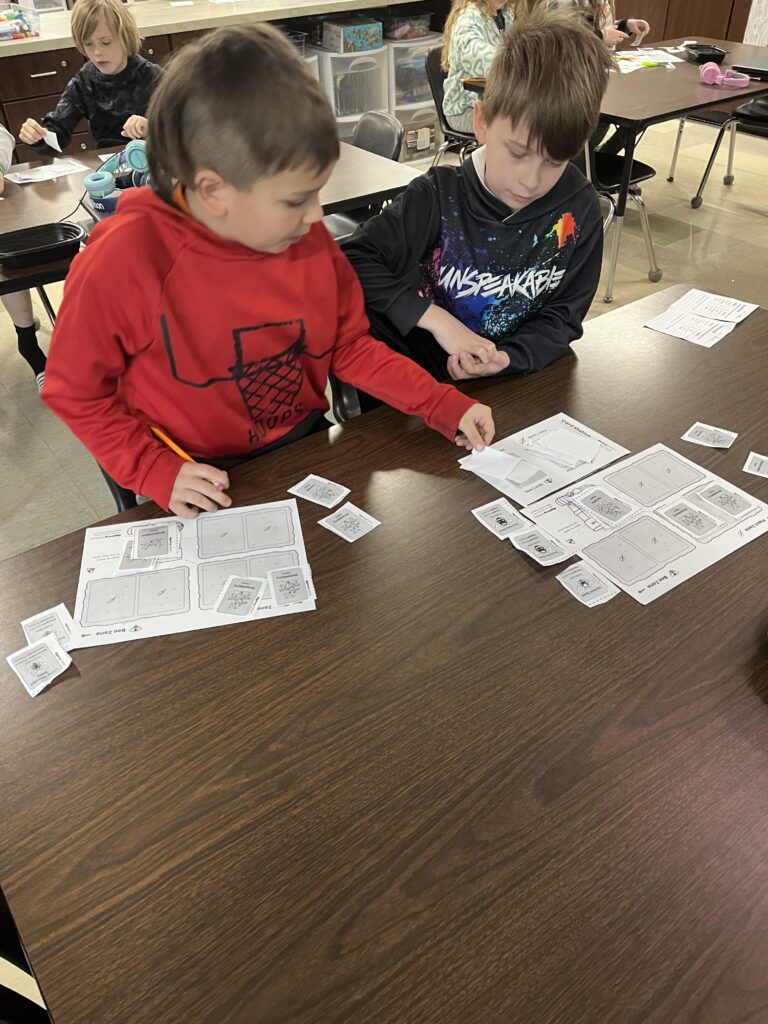


March 28th, 2025
STEM Student of the Week: Hunter Hageman

This week in STEM…
We celebrated the start of spring with a mini STEM challenge. Students worked with a partner to create a peep nest! They were given 20 linking cubes, plastic cups, pipe cleaners, and toothpicks to build a nest that could hold as many peeps as they could before the peeps fell out of the nest. The classes used the Engineering Design process to Ask, Imagine, Plan, Build, Test, Improve, and reflect. The students tested 3 different designs and recorded the results. There were some very impressive nests!
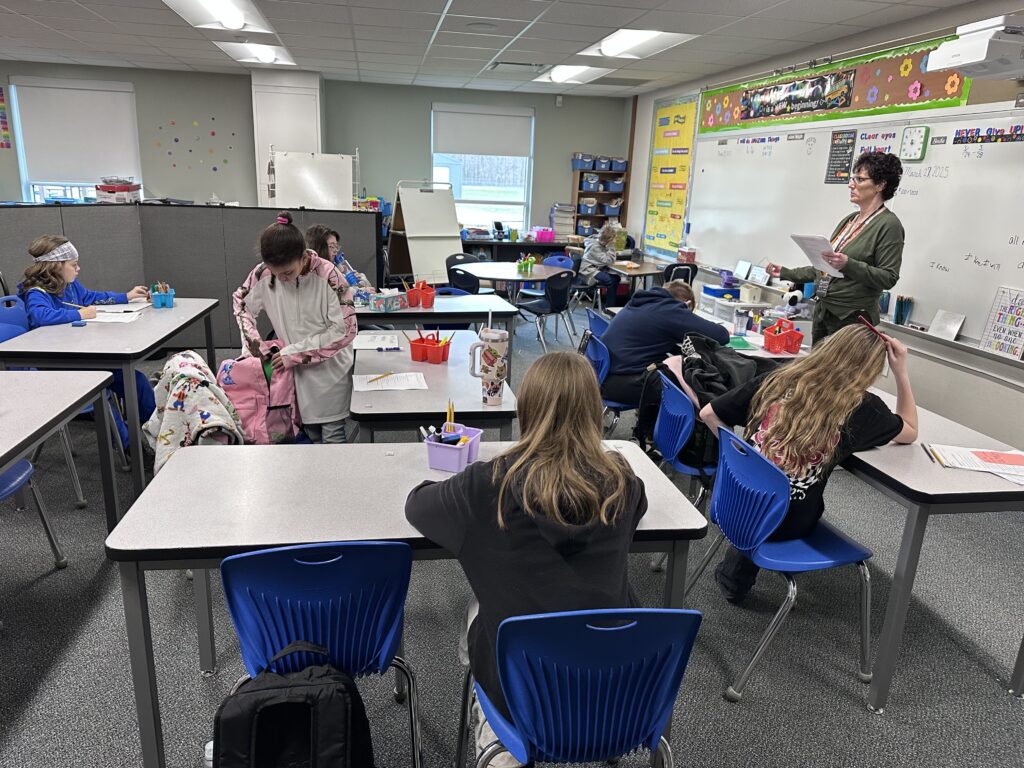
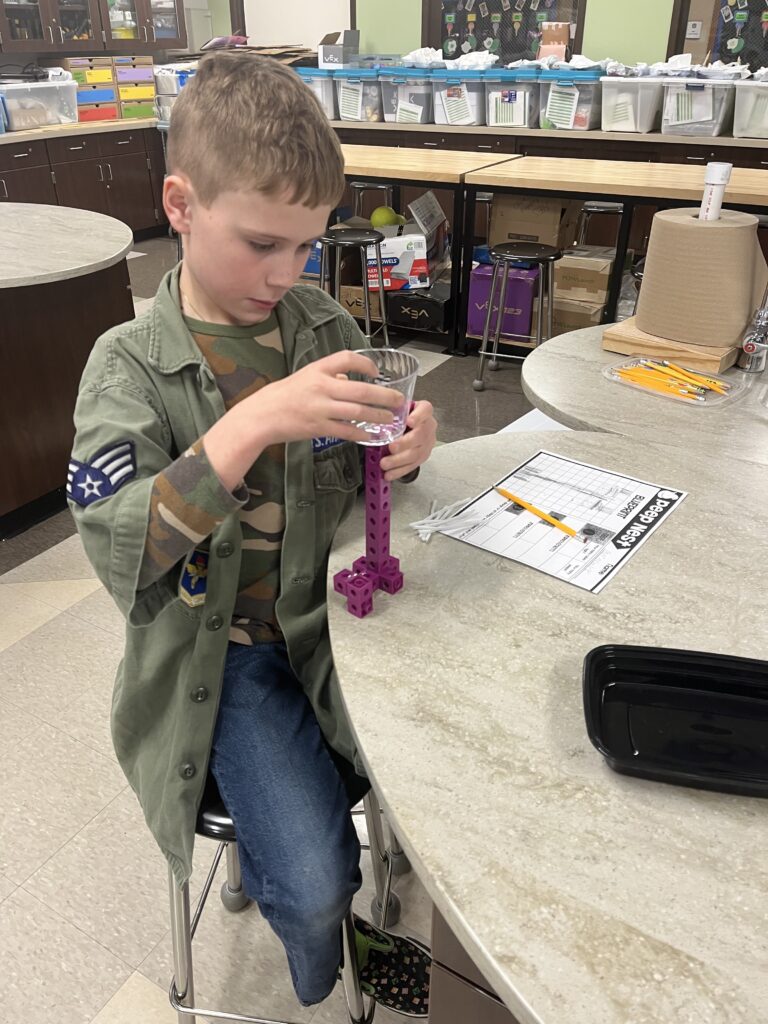


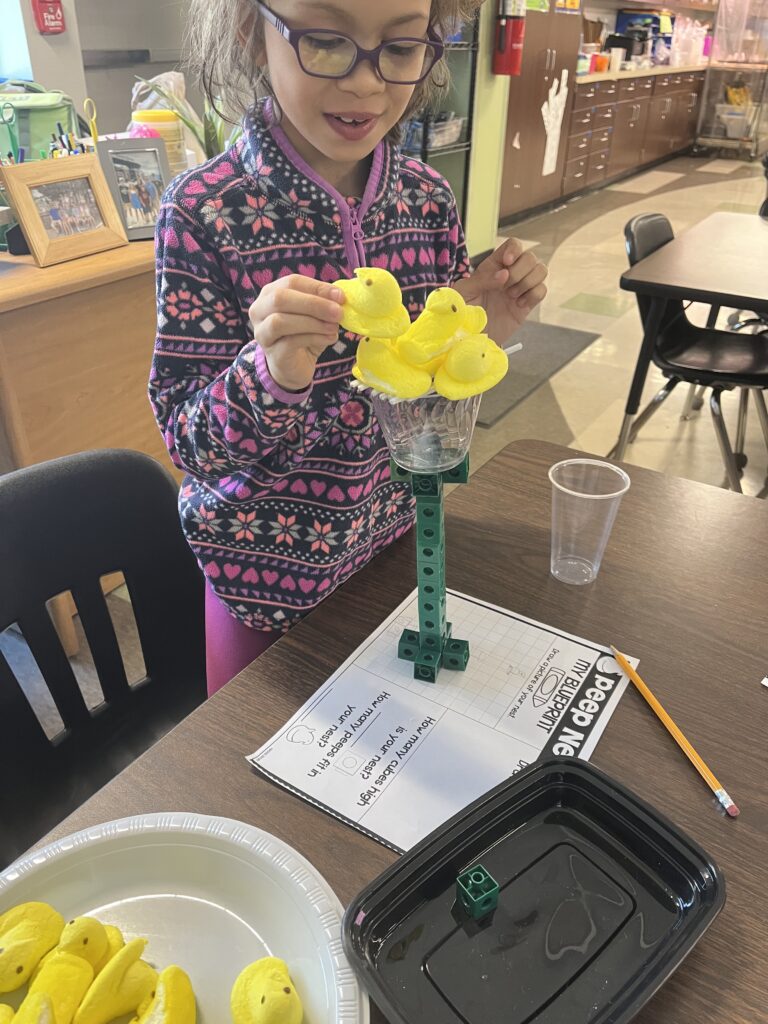





March 21st, 2025
STEM Student of the Week: Emerie Gossage

This week in STEM…
Fifth grade students finished their Stars and Planets unit with a planet project. Students picked one planet, researched, and created google slides with pictures, diagrams, maps, facts, and so much more. Then they presented them to the class.
Fourth grade students explored the role that air plays in enabling a sound vibration to travel. In the activity, Act Out a Sound, students did two short activities that explored sound vibrations. Students experimented with sound to understand how it moves through the air and then considered what would happen in an environment like space where there is no air. Students also experimented with sound waves using tuning forks.
Third grade students learned how and why flowers are pollinated. In the activity, Make a Flower, students made flower models out of paper and bee models out of pipe cleaners. Students flew their bees from flower to flower and observed what happens to the flower’s pollen during this process.
Second grade students began a new Science Unit: Plant Adventures! In this unit, students explore the needs of plants through hands-on investigations. They explore how and why plants disperse their seeds, what those seeds need in order to grow, and what the adult plants need in order to survive and thrive.
First grade students participated in a virtual lesson. In this Read-Along lesson, Arushi wonders why she has to go to bed while the sun is still up, and learns that the sun stays up longer on some days than others. The lesson included a short exercise where students get moving by acting out a bedtime routine.
Kindergarten students learned how rainbows are made and if you could ever find the end of the rainbow. We also talked about spring and the signs of changing seasons all around us.







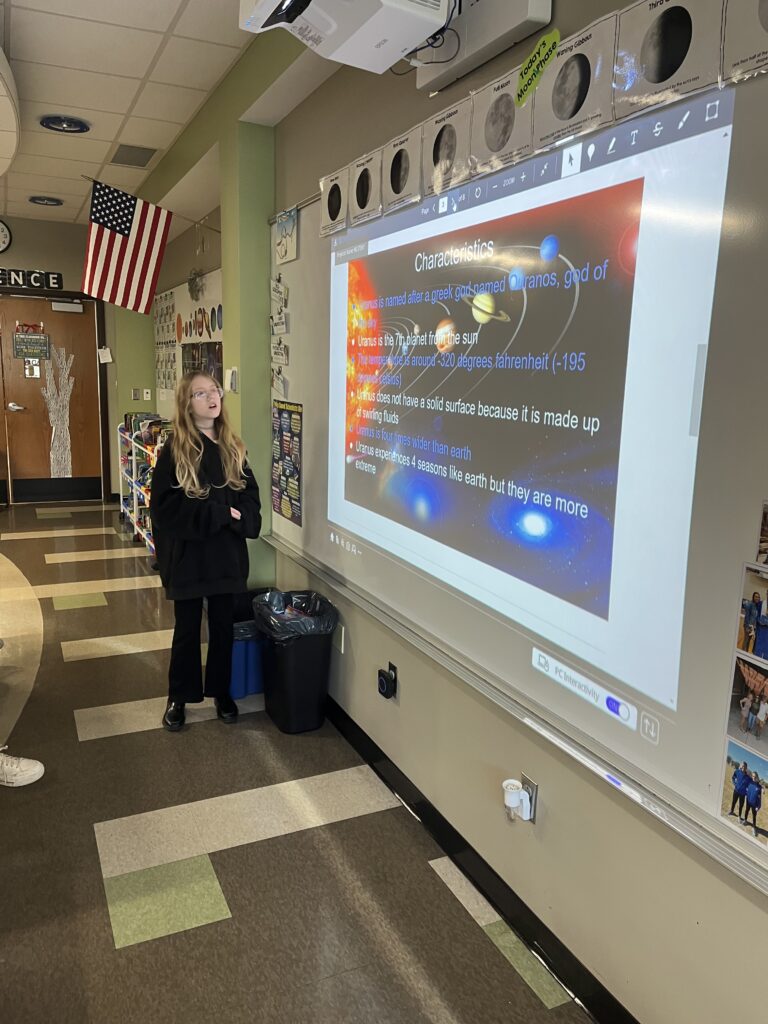



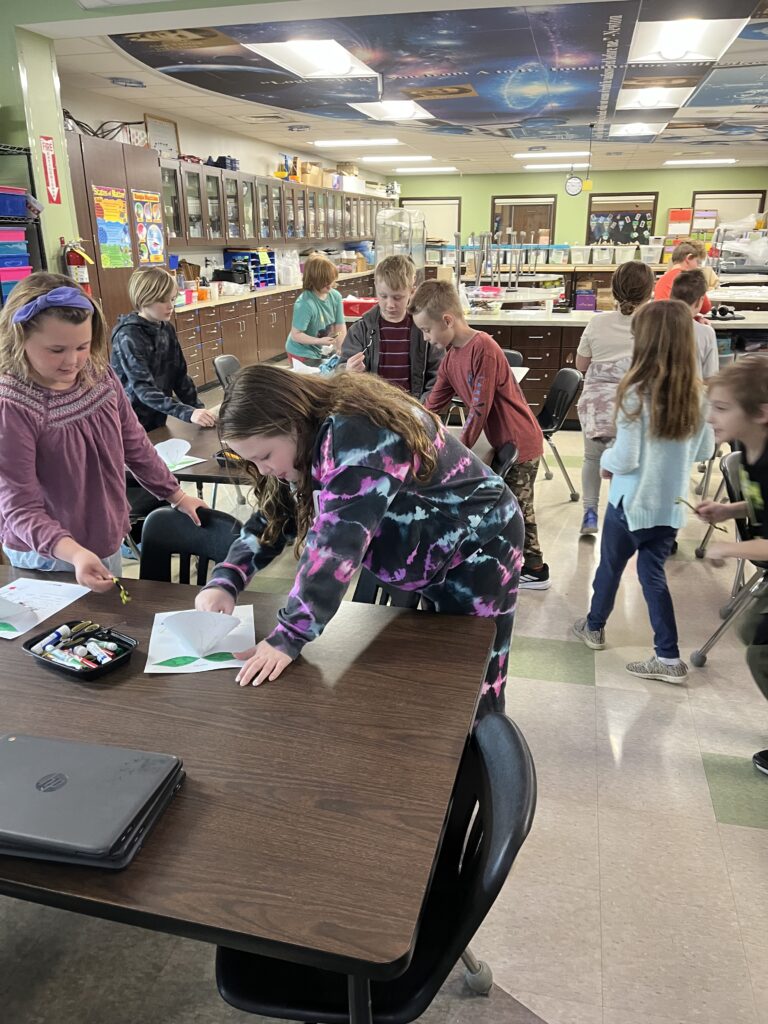

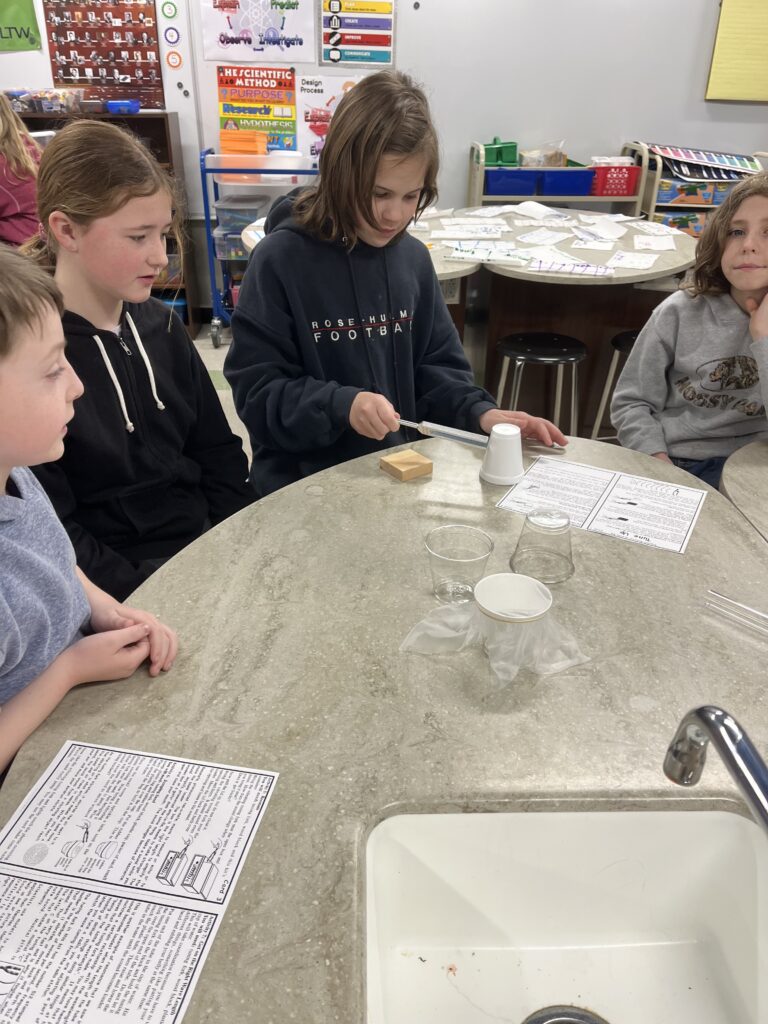
March 7th, 2025
STEM Students of the Month: HES Robotics Team
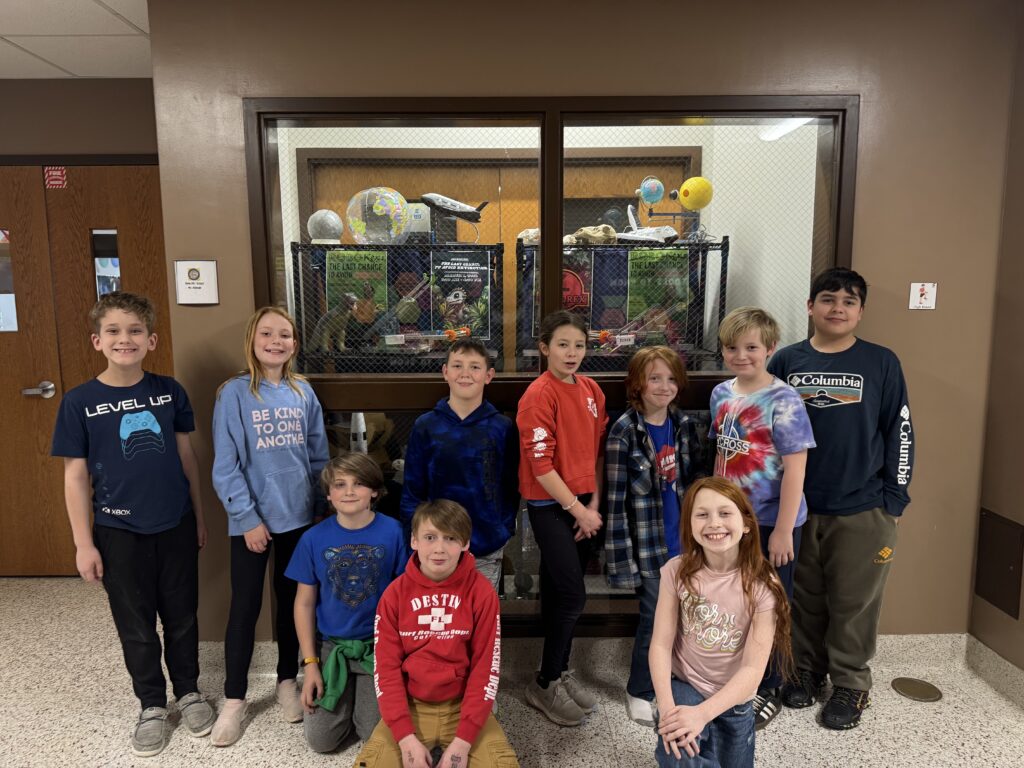
This week in STEM…
Fifth grade students discovered that the Earth is in the “Goldilocks Zone” — a distance from the Sun with the right amount of light and heat for life to exist. In the activity, Star Explorer, students planned a space mission to another planet outside our Solar System based on the amount of heat and light that reaches the planet’s surface. Once students planned their space mission, they reflected on what our Sun would look like from this far-away planet.
Fourth grade students learned about the connection between sounds and vibration. In the activity, Paper Cup Telephone, students made telephones using cups and string. Students then modified the design of their telephones using different types of supplies to see if they could improve the sound quality. Students also discovered that sound is a wave. In the activity, Making Waves, students drew the waves that different sounds make using a virtual oscilloscope, a machine that shows images of sound waves. Then they vibrated a rope to make waves that looked like the ones made by the oscilloscope.
Third grade students investigated mosquito life cycles and habitats and discovered the role of mosquitoes in carrying diseases such as malaria. In the activity, Bug Off!, students evaluated the merits of different solutions for getting rid of mosquitoes at various locations in a town. Students designed a solution to help the town deal with an abundance of mosquitoes resulting from a very rainy summer. We also had our Junior Master Gardening Club with the Purdue Extension office. This week we talked about overcrowding in gardens. Students planted a :garden: using seeds and paper towels. They also got to taste test sugar snap peas.
Second grade students explored a unique building material: mud! The properties of mud depend on the properties of the soil it’s made from. In the activity, Mystery Mud, students use models of clay to investigate how the properties of building materials can differ. They used the clay to build a model of a city built entirely from bricks made of mud.
First grade students developed a model of the sun’s daily path across the sky, then used this model to help someone who’s lost. In the activity, Sun Finder, students created a mobile paper model of the sun and earth to illustrate the position of the sun throughout the day.
Kindergarten students used observations of the four classic seasons to spot patterns and thereby determine the seasons’ order. In the activity, Circle of Seasons, students made observations of the four classic seasons of the temperate zone: snowy winter, warm spring, hot summer, and cool autumn with colorful leaves. Students spotted patterns and determined the order of the seasons.
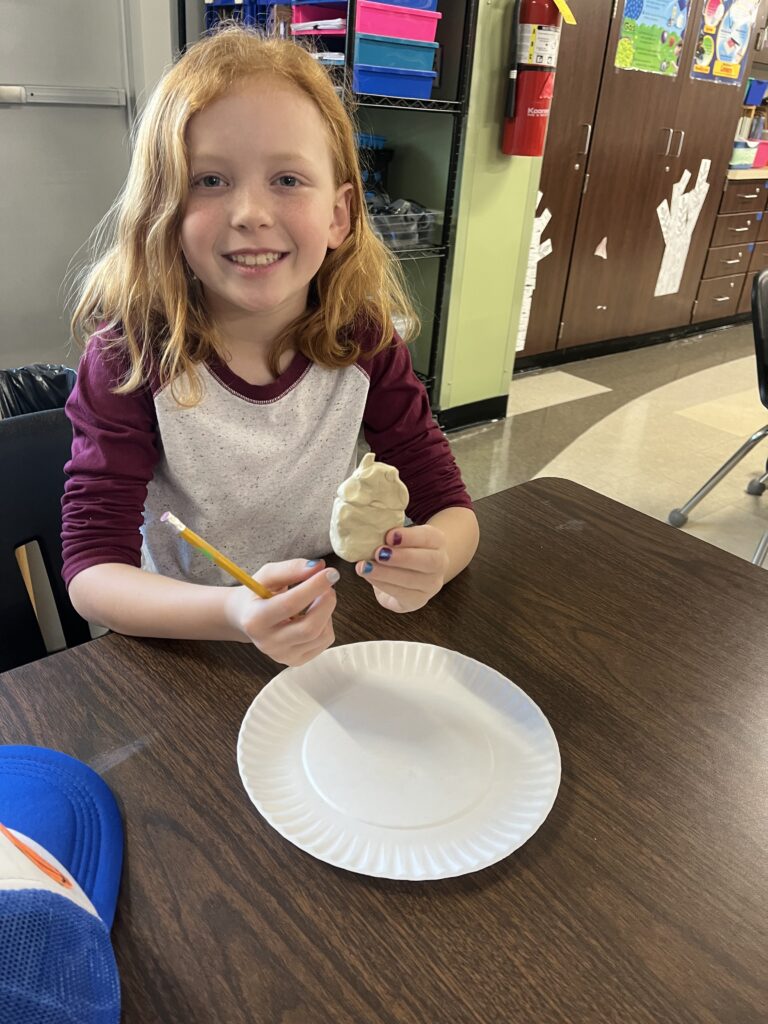











February 28th, 2025
STEM Student of the Week: Wyatt Brown

This week in STEM…
Fifth grade students discovered that gravity exists on all planets and moons, but the amount of gravity is different because it depends on how massive the object is. In the activity, Gravity Jump, students measured how high they can jump on Earth and then calculated how high they would be able to jump on other planets and moons within our Solar System.
Fourth grade students explored how digital devices encode complex information so that it can be transferred over long distances. In the activity, Secret Snacks, students generated their own codes in order to transfer information across the classroom. Then, they compared their codes and evaluated which worked best given the criteria and constraints.
Third grade students explored animal life cycles by thinking about their birthday buddies—all the animals that were born on the exact same day as they were born—and what happens to those birthday buddies over the course of their lives. In the activity, Birthday Buddies Timeline, students developed a model to compare the life stories of different animals. Using this model, students discovered that although the lives of animals can be very different, they all have in common birth, growth, reproduction, and death.
Second grade students examined how large structures like houses are built from smaller pieces. In the activity, Paper Towers, they designed their own structures using an unconventional building material: paper! Students built towers using 3″ x 5″ index cards and paper clips. First, they built tall towers, then they were challenged to build towers strong enough to support a hardcover book.
First grade students listened to a read-along lesson. In the read-along lesson, Jada explores why her shadow changes over the course of a day at the beach. The lesson included a short exercise where students acted out the movement of shadows with their bodies.
Kindergarten students listened to an illustrated digital storybook with student participation. In the story, Kevin becomes a weather detective to figure out why he keeps losing his warm clothes.

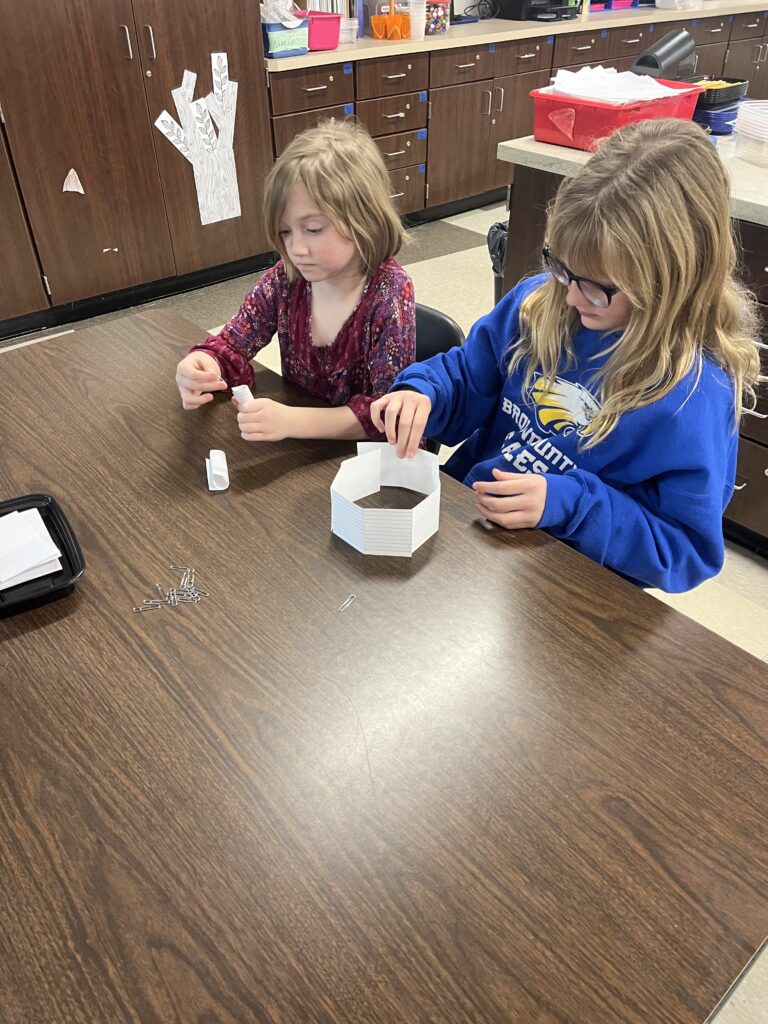



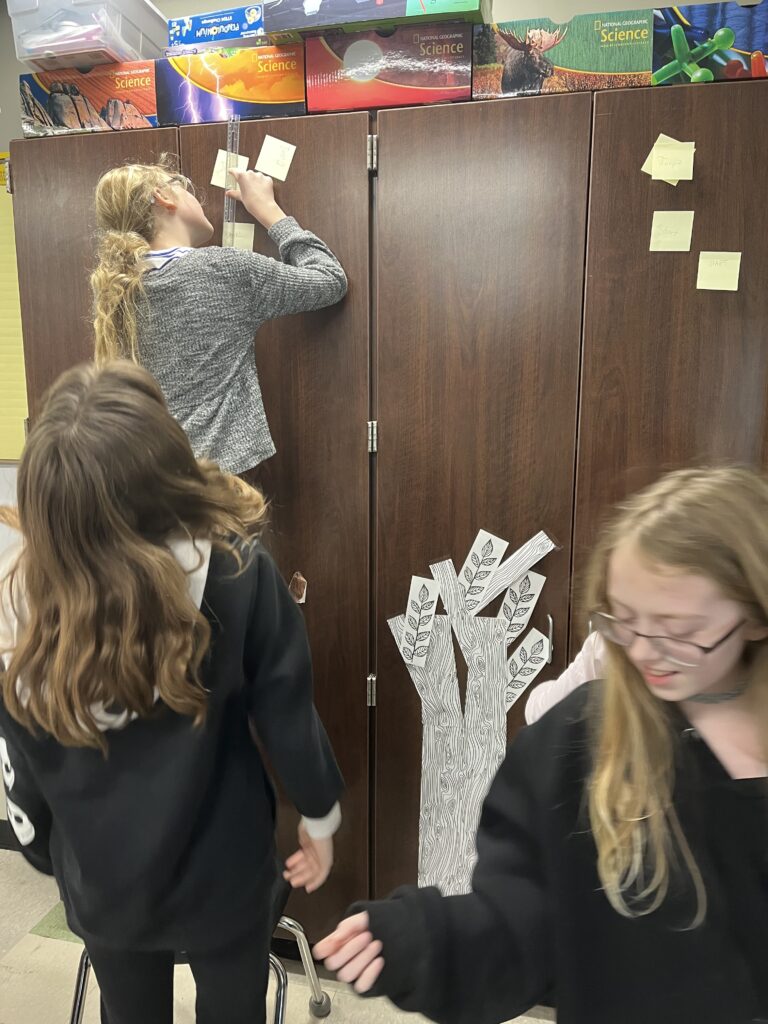





February 14th, 2025
STEM Student of the Week: Eva Deckard

This week in science…
Fifth grade students gathered evidence to support an argument that the apparent brightness of the Sun is dependent upon an observer’s distance from the Sun. In the activity, Solar Energy Explorer, students constructed a model solar system and gathered observations of the Sun’s apparent brightness from each planet within their model. Students then used those observations as evidence to support a claim about which planet is best suited to explore with a solar-powered planetary rover.
Fourth grade students finished up their Birth of Rocks unit. Students took everything they have learned and analyzed four rocks and the maps and photos from different locations to determine where each rock was found. They supported each of their claims with evidence.
Third grade students examined how physical traits can be influenced by the environment. In the activity, Astronaut-in-Training, students analyzed how a NASA astronaut’s traits changed during his “year in space.” Then they measured some of their physical traits (arm strength, height, and balance) and predicted how their own traits might change after living in space.
Second grade students learned how new materials are invented. In the activity, Bouncy Glass Inventions, students came up with ideas for inventions that use an exciting futuristic material: glass that bounces and stretches like rubber!
First grade and Kindergarten students learned about the invention of candy. We also learned which animal has the biggest heart.






February 7th, 2025
STEM Student of the Week: Oren Spalding

This week in science…
Fifth grade students were introduced to the Earth’s orbital movement around the Sun, as a means of seeing why the constellations change. In the activity, Universe-in-a-Box, students made a paper model that helps them visualize the Earth’s yearly orbit around the Sun. They used this model to understand why some constellations are only visible during part of the year. Students also explored why the Moon seems to change shape (phases) over the course of a month. In the activity, Model the Moon’s Phases, students used a styrofoam ball as a model of the Moon and a flashlight as a model of the Sun to gain a better understanding of how the interactions between the Sun and Moon are responsible for the Moon’s phases.
Fourth grade students gathered evidence to describe how environments on Earth have changed over time. Students explored how the process of sedimentary rock formation preserves a record of those past environments. In the activity, Canyon Explorer, students observed fossils found within a model canyon. The characteristics of those fossils provide evidence to support the explanation that the landscape has changed numerous times.
Third grade students discovered why dogs’ expressions, like tail wagging, are so useful when living in a pack. In the activity, Field Journal, students watched videos of different animals that live in groups to simulate observing them in their natural habitats. They discussed and recorded their observations, and constructed an explanation of how living in groups helps these animals survive.
Second grade students began a new science unit, Material magic. In this unit, students explore the properties of materials and matter! They describe and classify different types of materials by properties like hardness, flexibility, and absorbency, and they investigate how those properties are useful in meeting basic human needs (such as clothing and cooking). They also investigate how heating and cooling affect the properties of materials.
First grade students began a new unit, Sun and Shadows. In this unit, students make observations of the Sun and shadows throughout the day and across the seasons. They use their observations to understand patterns that occur throughout the day.
Kindergarten students learned about the tradition of Groundhog Day and if animals can really predict the weather.
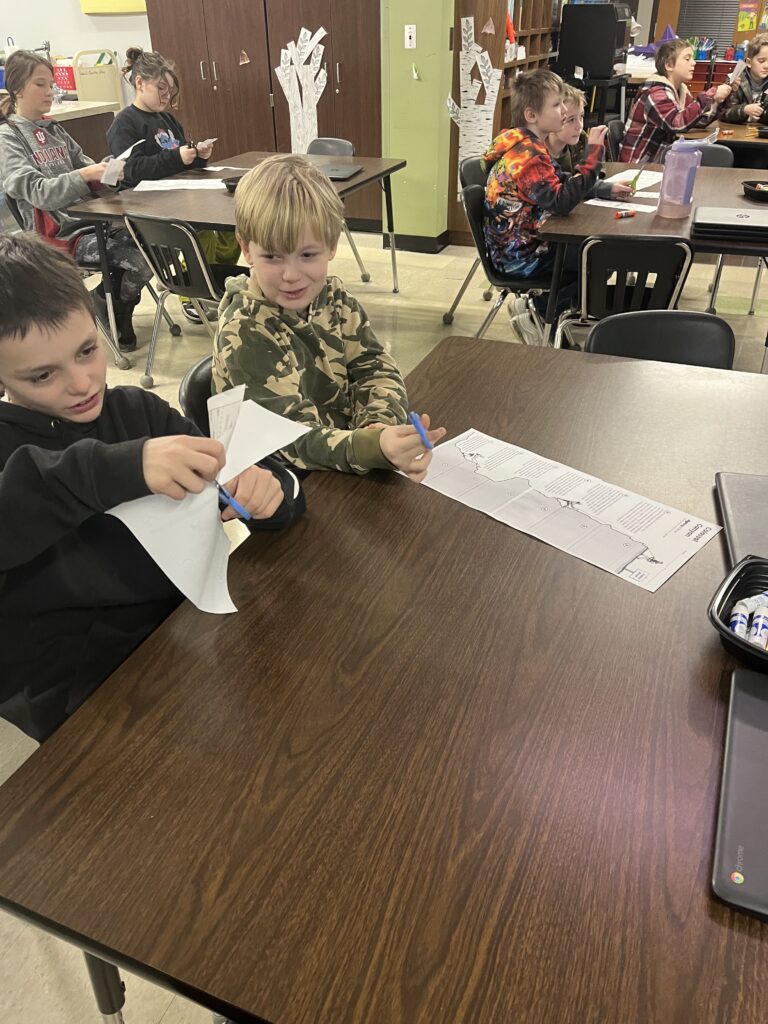

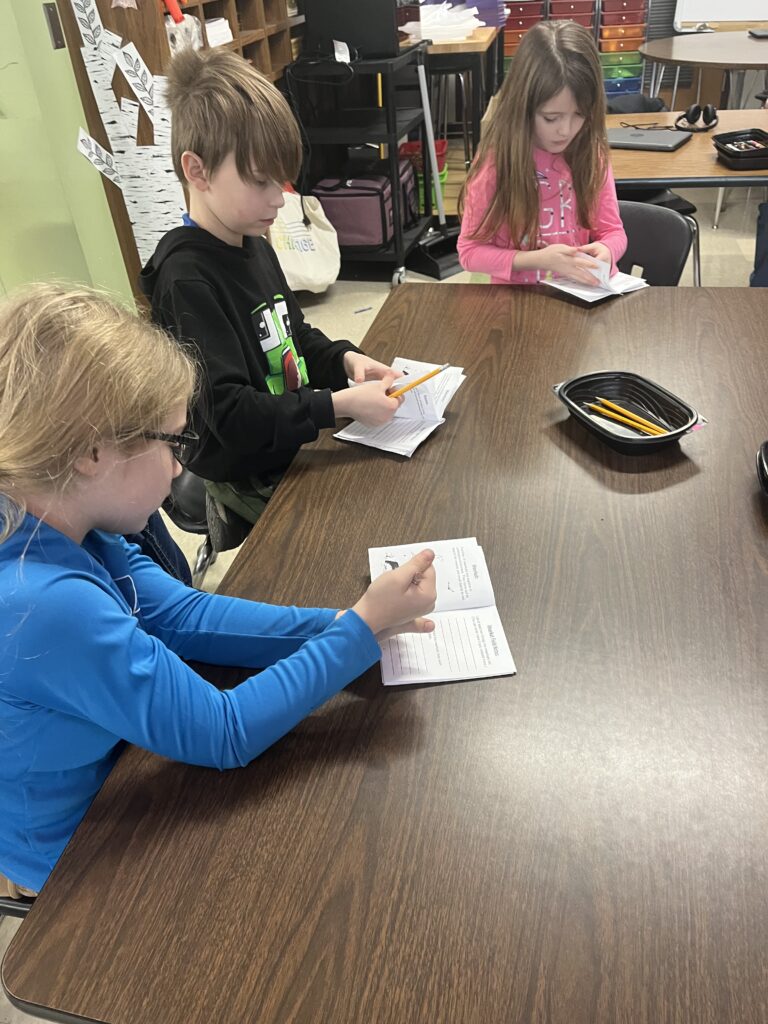

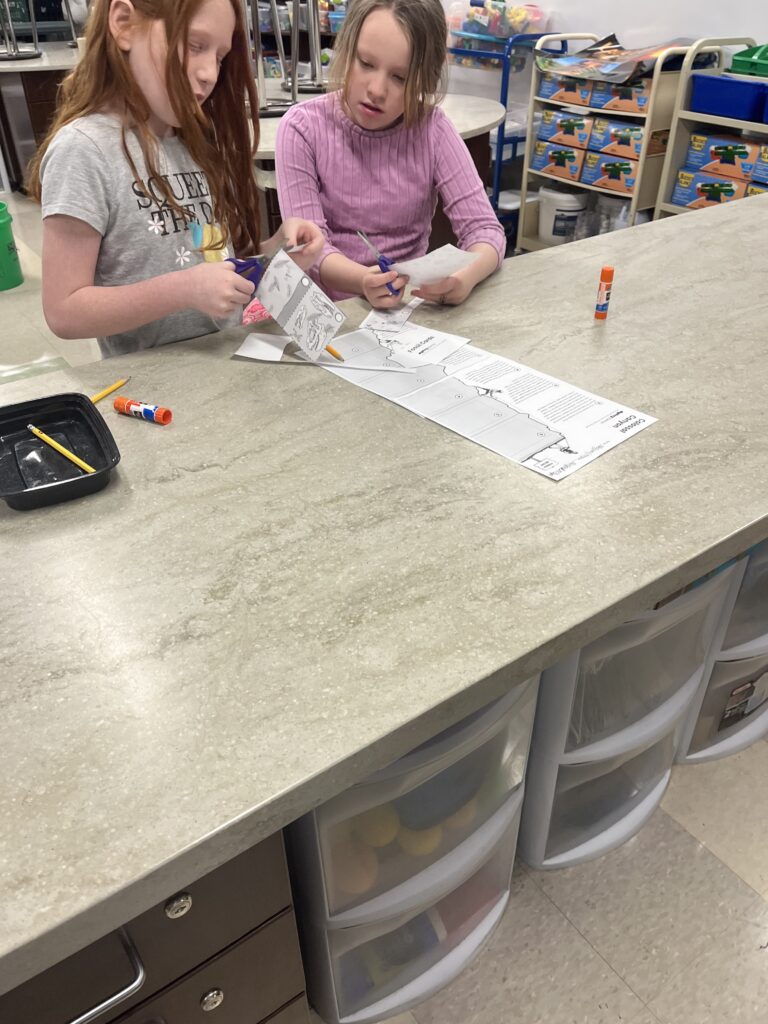


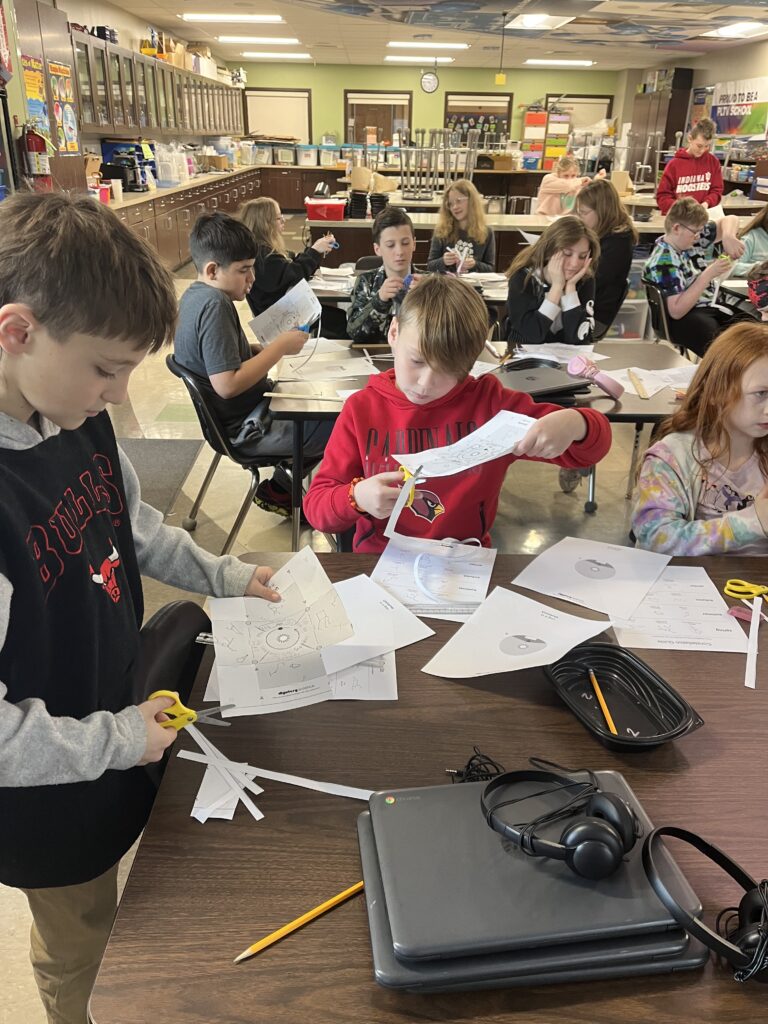

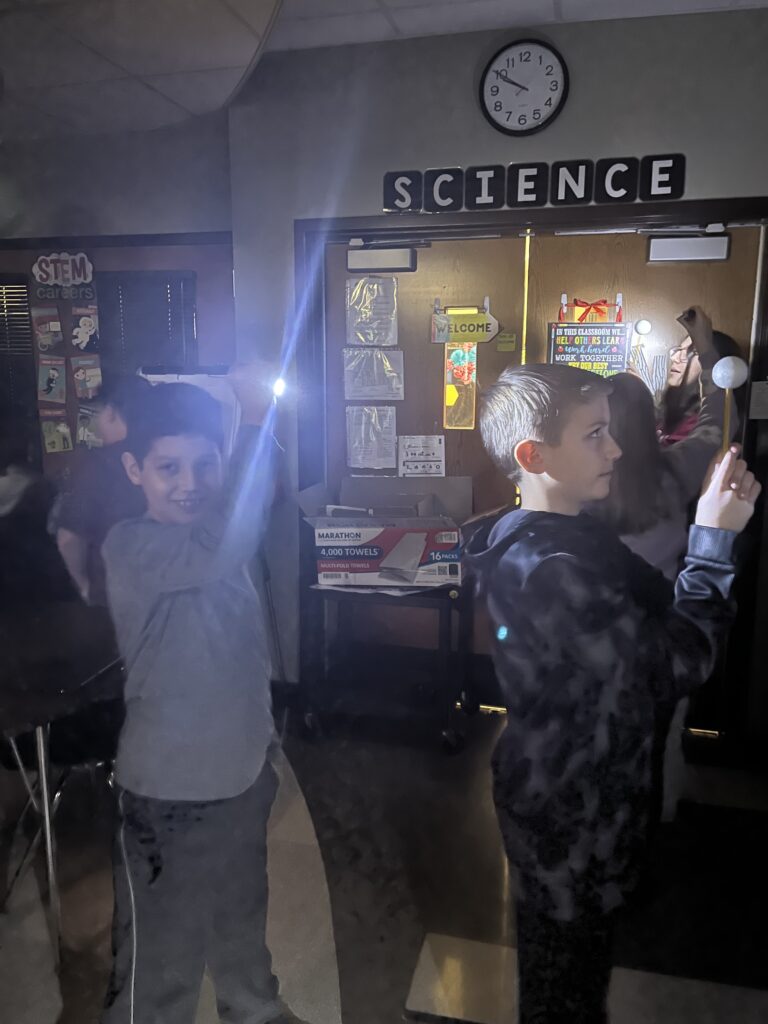
January 31, 2025
STEM Students of the Week: HES Science Bowl Team

This week in STEM:
Our 2025 Science Bowl team competed this week. The team worked very hard learning about this year’s topic: the Law of Conservation of Mass. Not only did the team study the three states of matter, but they also learned chemical compounds, solutions, solutes, solvents, elements, how to balance chemical equations and so much more. We will find out how we scored next week.
Students in grades K-5 continued coding this week on Code.org. Students also coded unplugged. We learned about other codes including morse code and practiced using it. Older students used binary code to create pictures as well.





January 24, 2025
This week in STEM…
Students in grade 3-5 continued with their coding unit while learning about binary code. Students wrote their own code for their partner to decode. They also got to make binary code bracelets.
Second grade students also continued with their coding unit. These students also learned how video games are made. Students then came up with their own sprite using pixel art.
Third grade students had their second Junior Master Gardening class. This week they learned about the tops, middles, and bottoms of plants and which part of the plant we eat. Students had to sort fruits and vegetables based on whether we eat the root, stem, flower, seed, leaf, or fruit part of a plant. We ended the class with another taste test. This time students had to use their five senses to describe bok choy.






January 17, 2025
STEM Student of the Week: Hadleigh Fawbush

This week in STEM…
Students in grades K-5 begin their coding unit in Code.org. Each grade level completes a Course and may work on smaller projects as well. The students also learn about binary code, sprites, pixel art, and the history of coding. It’s always fun to see how creative students are when writing their own code!
In addition to coding, our third grade students started their Junior Master Gardening program. Allison Roberts from the Purdue Extension 4-H Youth Program will come every Thursday to lead our third graders in the gardening program. This week the students learned about what plants need and how they support people and animals. They also described a carrot using their 5 senses.









December 20, 2024
STEM Student of the Week: Hadley Lambe

This week in science…
Fifth grade students discovered how the Sun’s path changes with the seasons. In the visual activity, Guess the Season, students figured out the season of the year by studying a photo. Students came to realize that they can use the time of day and length of shadows to figure out the season in each photo.
Fourth grade students explored how solid rock breaks apart into smaller pieces through a process called weathering (including root-wedging and ice-wedging). In the activity, Sugar Shake, students used sugar cubes as a model for rocks. They performed an experiment with this model to understand the process of weathering and how this process explains why rocks at the tops of mountains are jagged, while those at the bottom are rounded.
Third grade students explored how variation in the toe scales of green lizards provides some individuals with an advantage when it comes to climbing and surviving. In the activity, Lizard Island, students participated in a simulation to explore what happens to these green lizards when a new species of brown lizards is introduced to their environment. Students gathered evidence to explain how a change to the environment can cause a certain trait to become more common in a population over time through the process of natural selection.
Second grade students learned the importance of handwashing and keeping a distance when they are not feeling well. Nurse Sherri Rice from the Health Department came and demonstrated how easy germs can spread. Students were also given lotion and a black light to simulate germs on their hands.

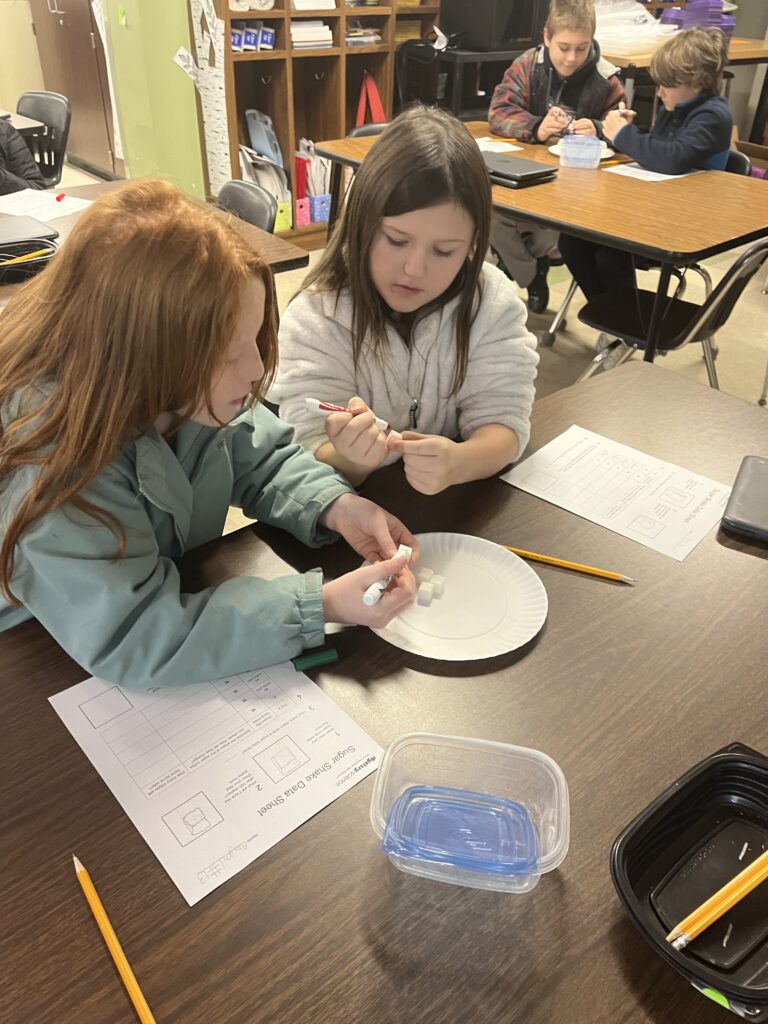
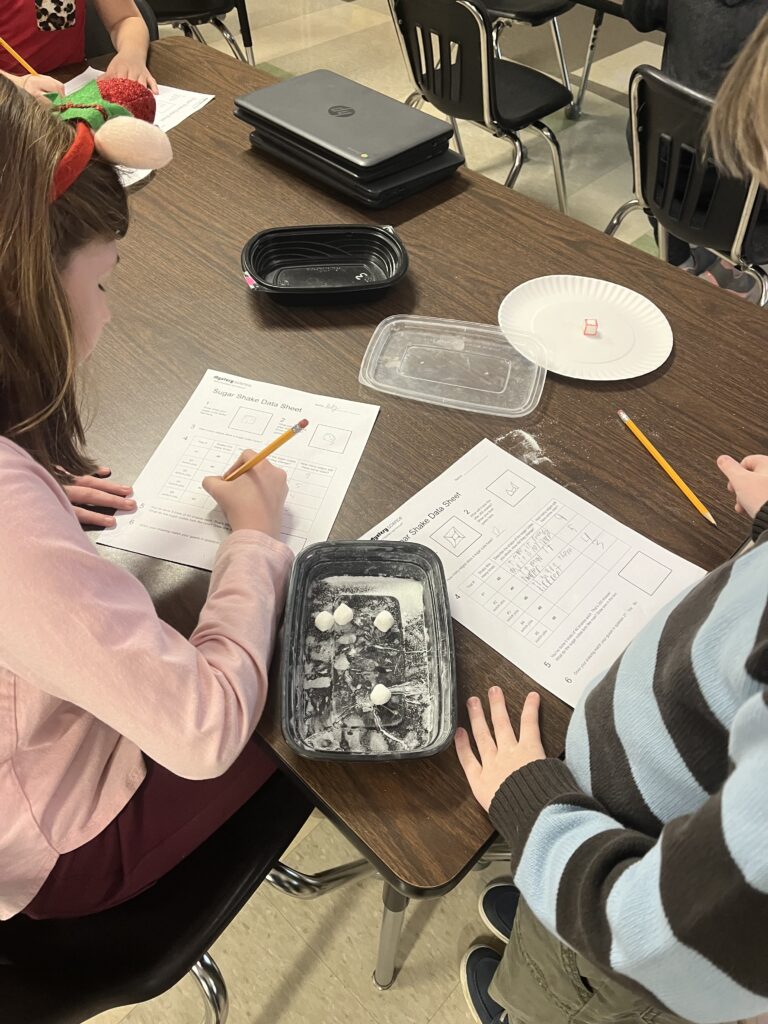
December 6, 2024
STEM Student of the Week: Emmylou Fulton

This week in science…
Fifth grade students came to understand that the setting Sun isn’t moving, the Earth is spinning. In the activity, Spinning Earth, students used their bodies as a kinesthetic model of the Earth to understand how the speed of the Earth’s spin affects the length of a day. They also learned why our ancestors divided the day into hours and how clocks measure the Sun’s apparent movement. In the activity, Make a Shadow Clock, students made their own sundials. First, students used flashlights indoors to understand how the position of the light affects the time shown on the clock. Then, students took their shadow clocks outside to see how the position of the Sun can tell them the time of day.
Fourth grade students investigated how differences in lava types explain differences in the shape and eruption patterns among volcanoes. In the activity, Bubble Trouble, students compared two different types of “lava” — thin and thick. They used this information to figure out why volcanoes have different shapes and how the type of lava explains why some volcanoes explode.
Third grade students explored the extreme trait variation of different dog breeds — and pet pigeon breeds! In the activity, Pigeon Pairings, students analyzed trait similarities and differences among parent, offspring, and sibling pigeons. They interpreted this data to discover that the variation and inheritance of traits creates a pattern that explains why we see such extreme traits in artificially selected animal breeds.
Second grade students started their Digital Citizenship unit this week. We will spend the rest of the month learning about digital citizenship and safety. This week’s topic was all about the importance of device free moments.
First grade students started their Digital Citizenship unit this week. We will spend the rest of the month learning about digital citizenship and safety. This week’s topic was all about how we can be safe, responsible, and respectful online.
Kindergarten students observed and described the weather, paying attention to the sun, the temperature, the wind, and precipitation. In the activity, Be a Weather Watcher, students observed and drew the weather around them.







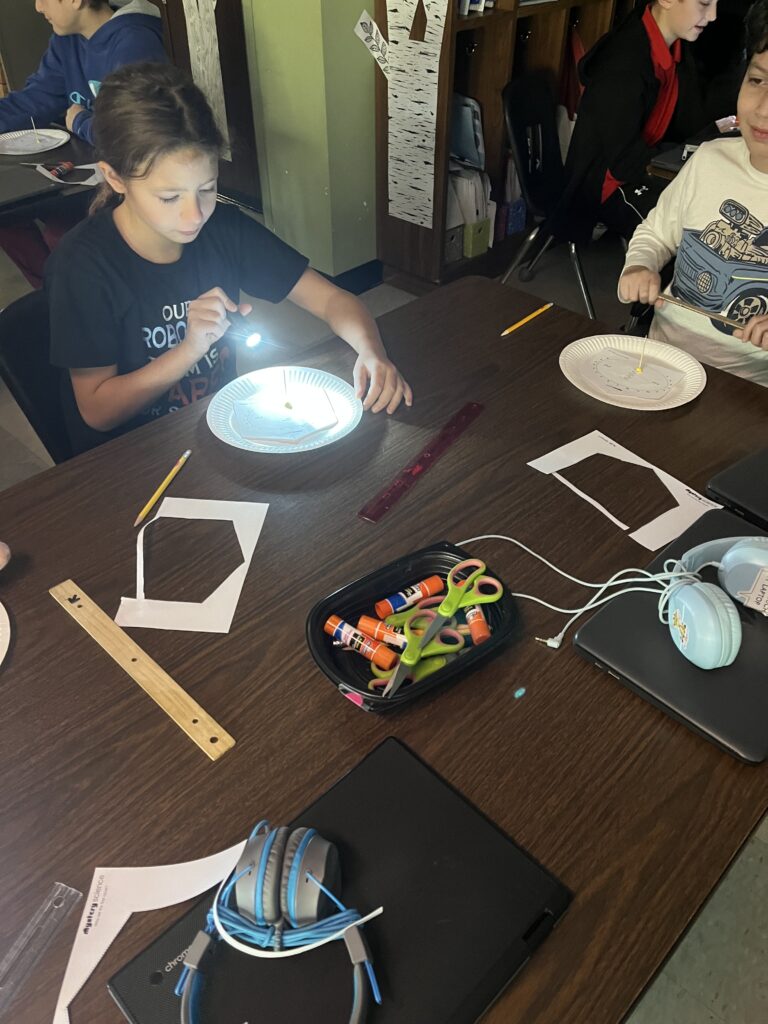





November 22, 2024
STEM Student of the Week: Wade Brown

This week in Science…
Fifth grade began their new Science Unit, Earth & Space Patterns. In this unit, students explore patterns of the Earth, Sun, Moon, and stars. They investigate how shadows change throughout the day, how the Sun’s position changes throughout the year, and how stars change throughout the seasons. They also create Earth, Sun, and Moon models to explore Moon patterns.
Fourth grade students explored the past and present pattern of where volcanoes exist on the earth. In the activity, Mapping Volcanoes, students plotted volcano locations on a world map and looked for patterns. Students analyzed these maps to discover that volcanoes form a “Ring of Fire” around the Pacific Ocean.
Third grade students examined plant traits and used that information as evidence to help them identify an unknown fruit. In the activity, Fruit Market Mysteries, students looked for similarities and differences in the leaves, flowers, and fruits of plants found at the grocery store to sort them into groups and identify patterns of inheritance.
Second grade students compared multiple solutions for preventing erosion. In the activity, Erosion Engineering, they designed and tested ways to keep water from washing away a hill modeled out of cornmeal.
First grade students participated in a read and act along lesson. In this Read-Along lesson, Amy notices that baby animals look a lot like the adults in their families—and then discovers that she does, too! The lesson includes a short exercise where students get moving by acting like farm animals.
Kindergarten students participated in a read and act along lesson. In this Read-Along lesson, students listen to an illustrated digital storybook with student participation. In the story, JJ and his grandfather get ready for a big thunderstorm. In the activity, Get Ready for a Storm, students learn about other kinds of storms and act out ways to prepare for storms.







November 15, 2024
STEM Student of the Week: Remy Mangin
This week in STEM:

Fifth grade students participated in a STEM challenge this week in honor of National STEM Day. After finishing up their Web of Life unit they took what they learned and made models of an animal and their source of energy. They were so creative!
Fourth grade students also participated in a STEM challenge to wrap up their Animal Adaptations unit. Students were challenged to create a model of an animal that highlighted that animal’s adaptation to their environment. Students then presented their creation to the class.
Third grade students finished their Stormy Skies unit this week. In the Performance Task, students analyzed and represented real weather data in tables and bar graphs in order to forecast hail storms during different seasons and in different regions of the United States.
Second grade students made hypotheses and investigated the causes of canyons. In the activity, Cornmeal Canyons, students created a model landform using cornmeal. Then they dripped water over this “land” to observe how water can change its shape and to understand how, over long periods of time, canyons can be formed through a similar process.
First grade students made observations to construct an explanation of why camouflage is helpful to animals. In the activity, Moth Hide and Seek, students tested their ability to spot camouflage moths, and then designed a camouflage pattern for a moth of their own and hid it in the classroom!
Kindergarten students began a new science unit this week called Wild Weather. In this unit, students explore storms and severe weather! They obtain information from weather forecasts to prepare for storms and stay safe. They also practice describing the various characteristics of weather (wind, clouds, temperature, and precipitation) in order to make their own predictions about storms.




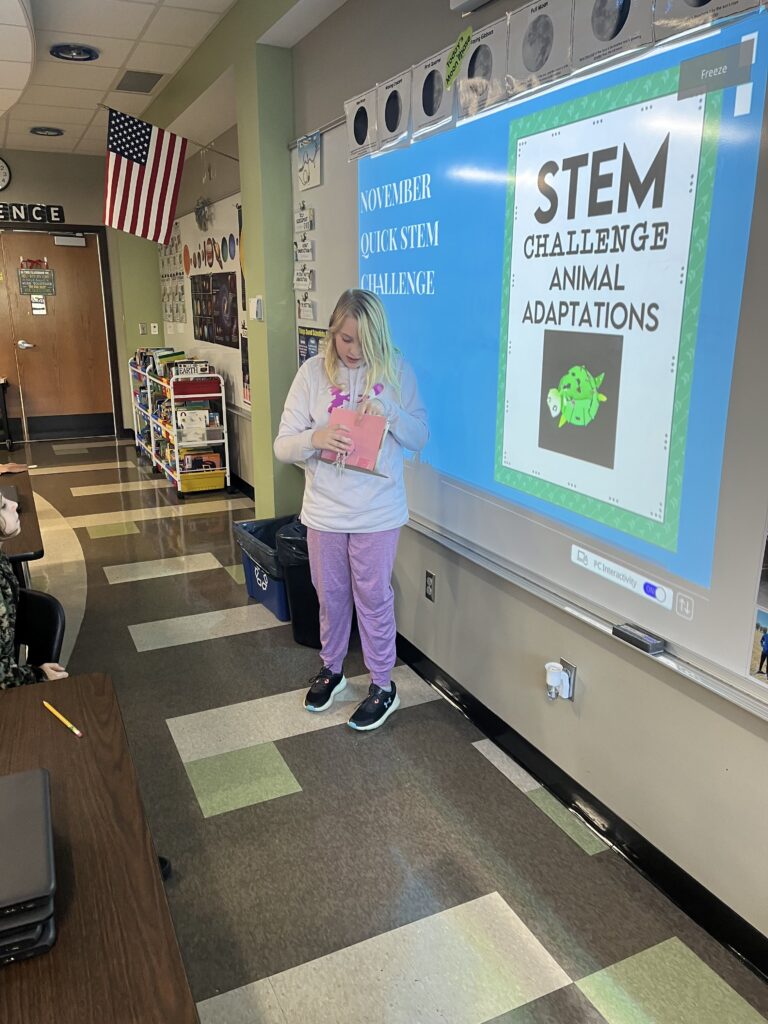








November 8, 2024
STEM Student of the Week: Maxwell St. John

This week in Science…
Fifth grade students investigated the hypothesis that an asteroid impact caused the extinction of the dinosaurs. In the activity, Create a Dinosaur Food Web, students used cards and construction paper connectors to create a food web from the time of the dinosaurs. Using this model, they followed the flow of energy through the food web and figured out why dinosaurs went extinct but some other animals survived.
Fourth grade students made observations of external and internal parts of trees in order to collect evidence that these structures work together as a system to help plants survive in a particular environment. In the activity, Tree Detective, students used models of roots and branches to explore their functions and then constructed an argument about how these structures must work together in order to support the survival of trees in the unique environment of the frozen taiga.
Third grade students were introduced to the concept of “climate” and explored the world’s five major climates. In the activity, Climate Decoder, students colored one part of a world map to figure out the different climates of that region. Students then combined maps and searched for global climate patterns.
Second grade students explored the phenomenon of flash floods and created an explanation of why these severe weather events are more or less likely in different regions. They specifically attempted to locate and explain a unique region in Texas known as Flash Flood Alley. In the activity, Find Flash Flood Alley, students developed a map to document how land and water interact across the state. Students then used that map to explain how different shapes and kinds of land increase or decrease the chances of rainfall causing a flash flood.
First grade students participated in a lesson called, “Why do baby ducks follow their mother?”. In this Read-Along lesson, Juan Carlos visits his grandmother who has a backyard full of ducks. The lesson includes a short exercise where students get moving by acting like ducks.
Kindergarten students learned all about scarecrows. They learned where scarecrows originated and even about modern day scarecrows like cameras and flashing lights. They ended their lesson with labeling the different parts of a scarecrow.








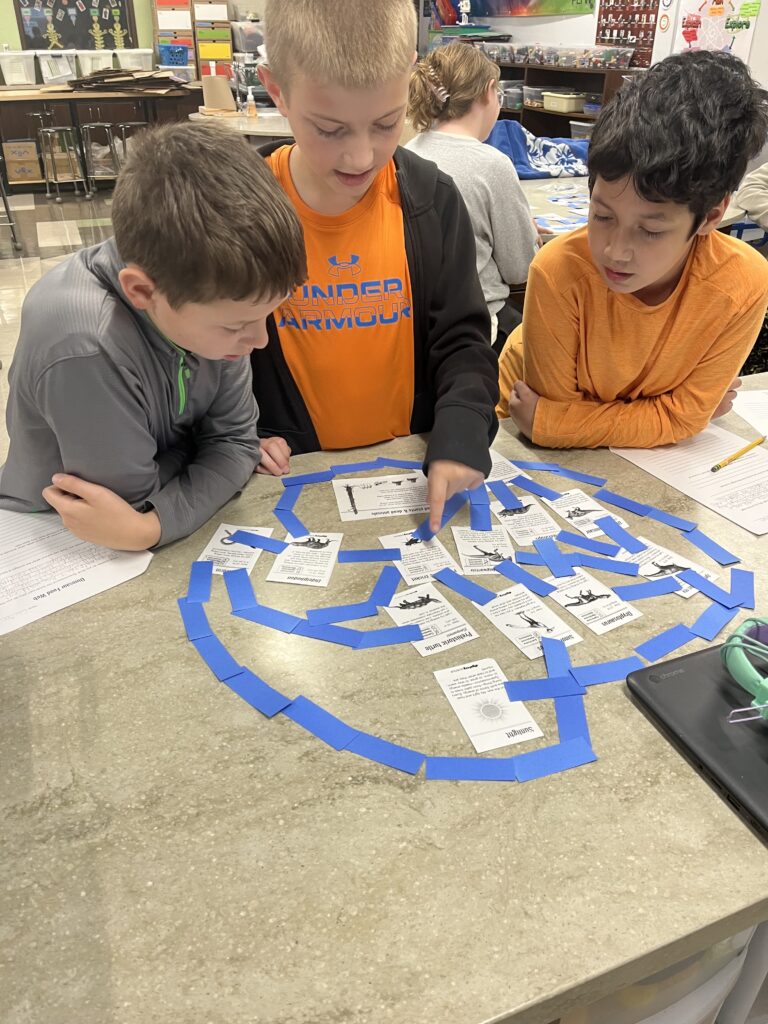
November 1, 2024
Scientist of the Week: Tucker Reichmann

This week in Science…
Fifth grade students discovered what happens in unbalanced ecosystems and how that can lead to an overabundance of algae and harmful algal blooms. In the activity, Bloom Busters, students played a game in which they obtained and combined science ideas in order to help a community respond to and prevent harmful algal blooms.
Fourth grade students explored how animals receive information through their senses and process that information in their brain, using instincts and memories to guide their behaviors. In the activity, Raccoon Reactions, students used models to understand how an animal’s senses, brain, and memories all work together as a system to influence their behavior and support their survival.
Third grade students explored seasonal weather conditions across different regions. They investigated how weather patterns can be used to make predictions about future weather. In the activity, Snow Fort Weather, students organized daily temperature data from three snowy towns into a table so that they can compare weather conditions and predict which town is most likely to have the best weather for a snow fort festival next year.
Second grade students investigated the effects of rocks tumbling in a river. Based on their observations, they constructed an explanation for why there is sand at a beach. In the activity, Rocking the River, students pretended to be a river and tore up pieces of construction paper to model what happens to rocks as they travel along the river.



October 25, 2024
STEM Student of the Week: Josephine Martin

![]() Helmsburg Elementary had an incredible pumpkin-themed STEM day!
Helmsburg Elementary had an incredible pumpkin-themed STEM day! ![]()
Students kicked off the day by making predictions about the weight, circumference, and number of seeds in their pumpkins. They then weighed, measured, and counted to see how close they were! They also created pumpkin volcanoes, experimenting with baking soda, dish soap, and vinegar reactions for a hands-on science experience.
In music, they crafted pumpkin drums and string instruments, while in art, they created fizzy pumpkin paintings and paper pumpkins. Gym class featured exciting pumpkin relay races, and in science, students built towering pumpkin structures.
A huge thank you to Joey Dallas for donating the giant pumpkin and straw bales! Congratulations to our pumpkin weight-guessing winners: Rylee, Juniper, and Emmett! ![]()










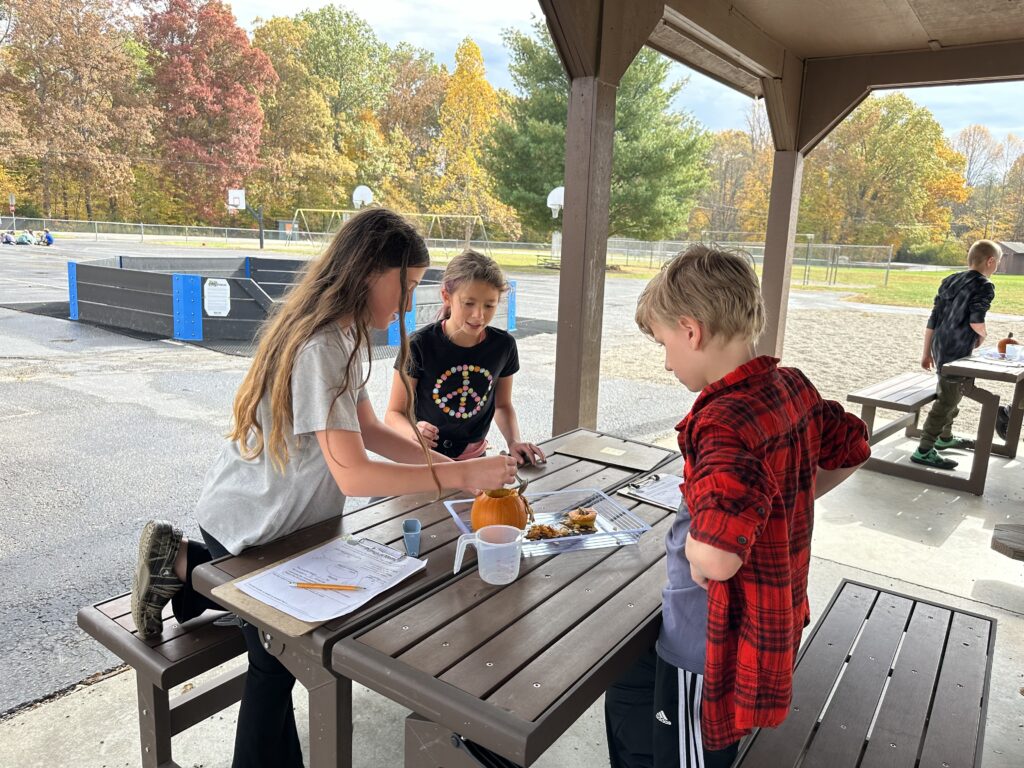
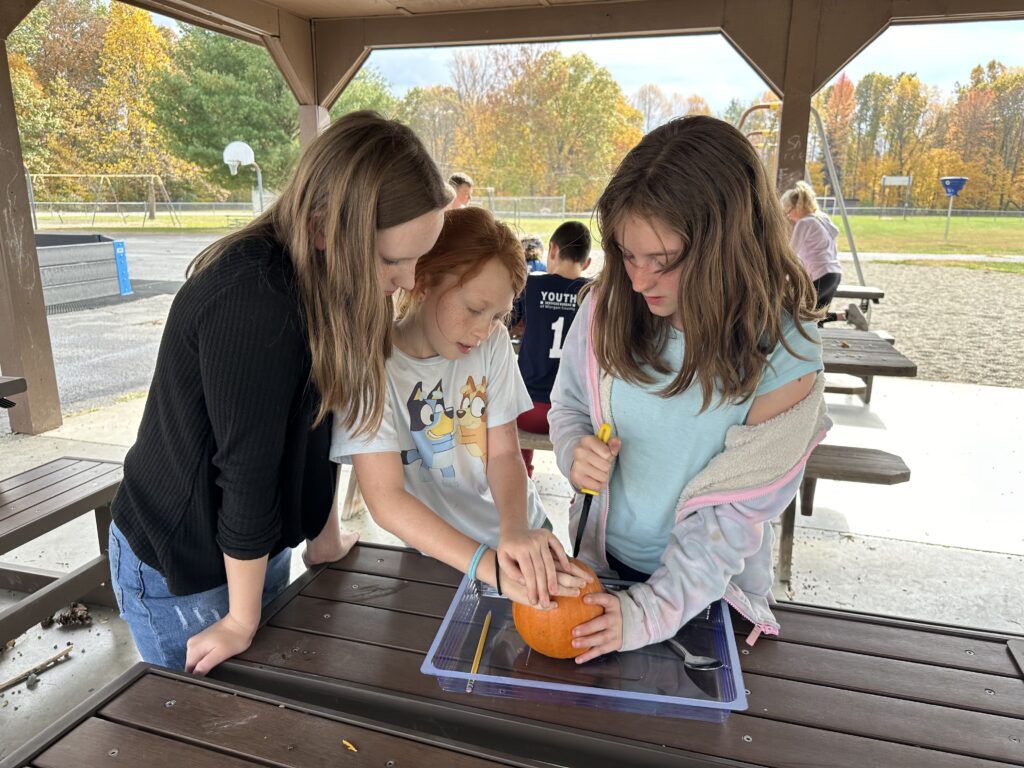




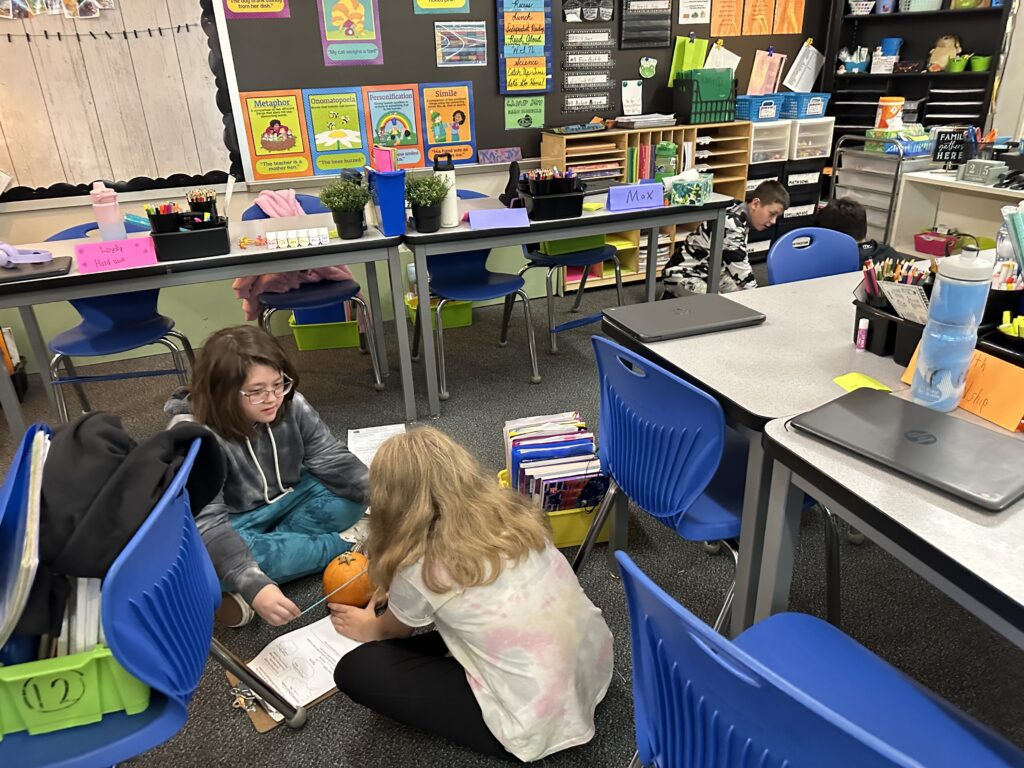


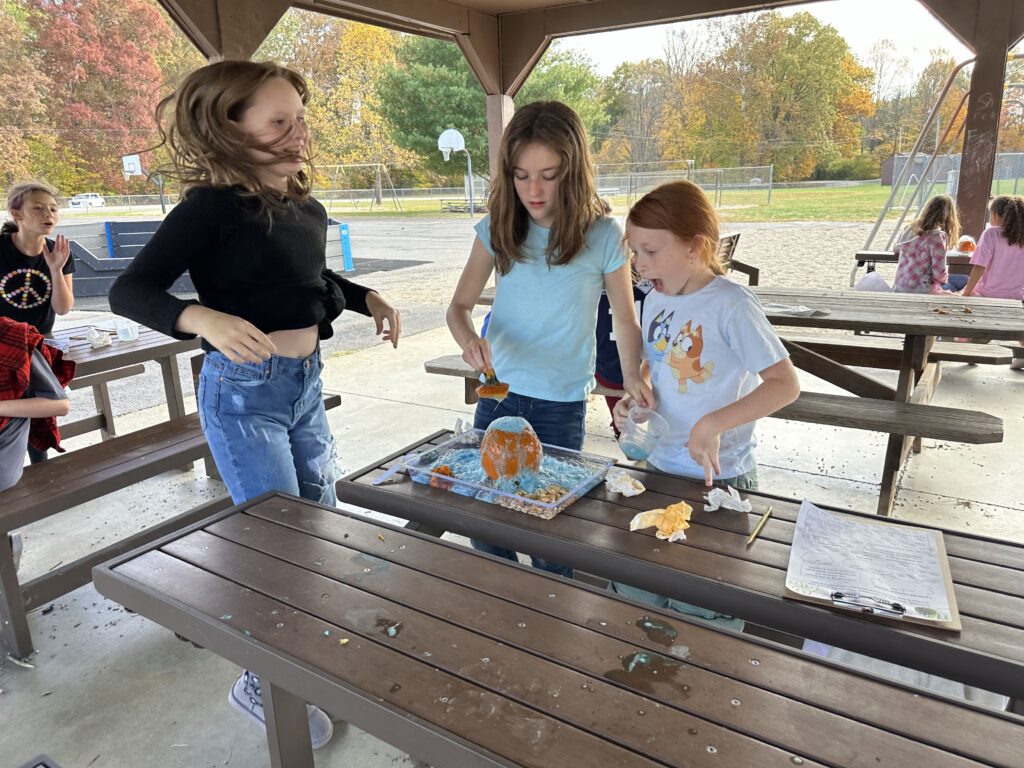























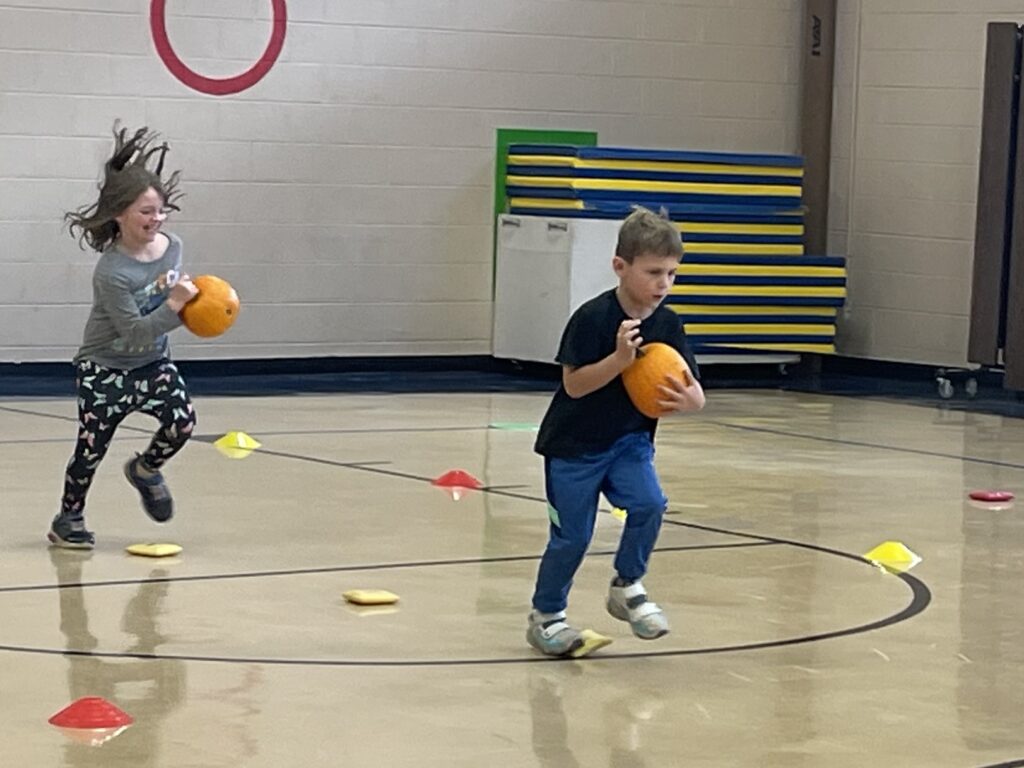





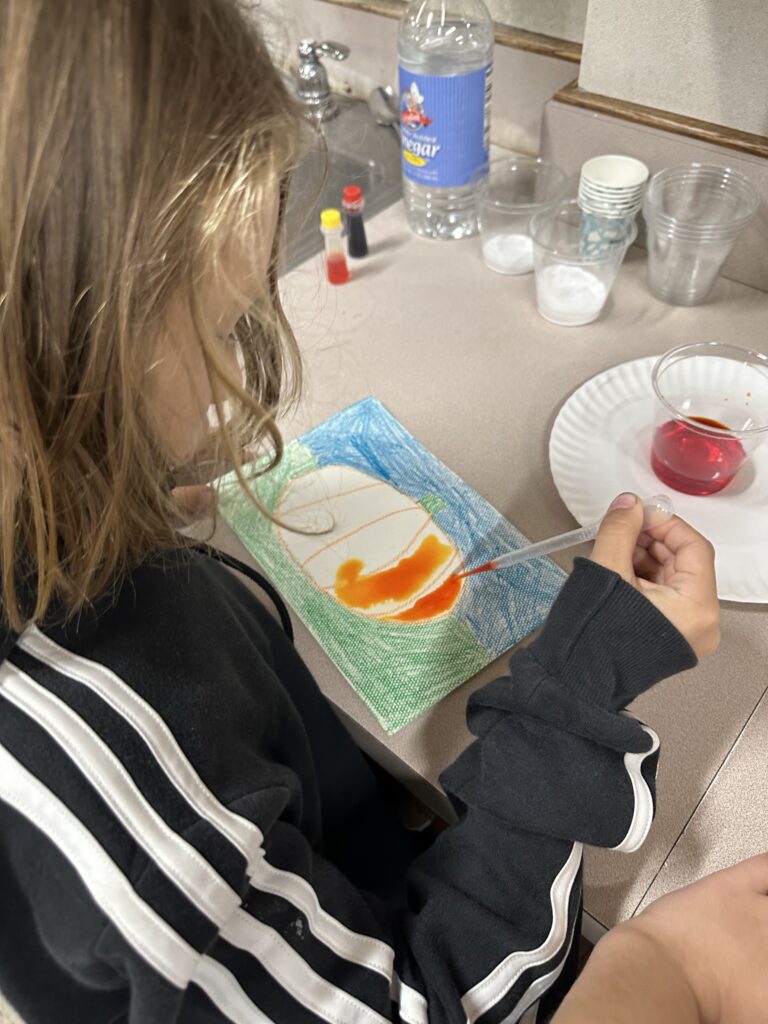










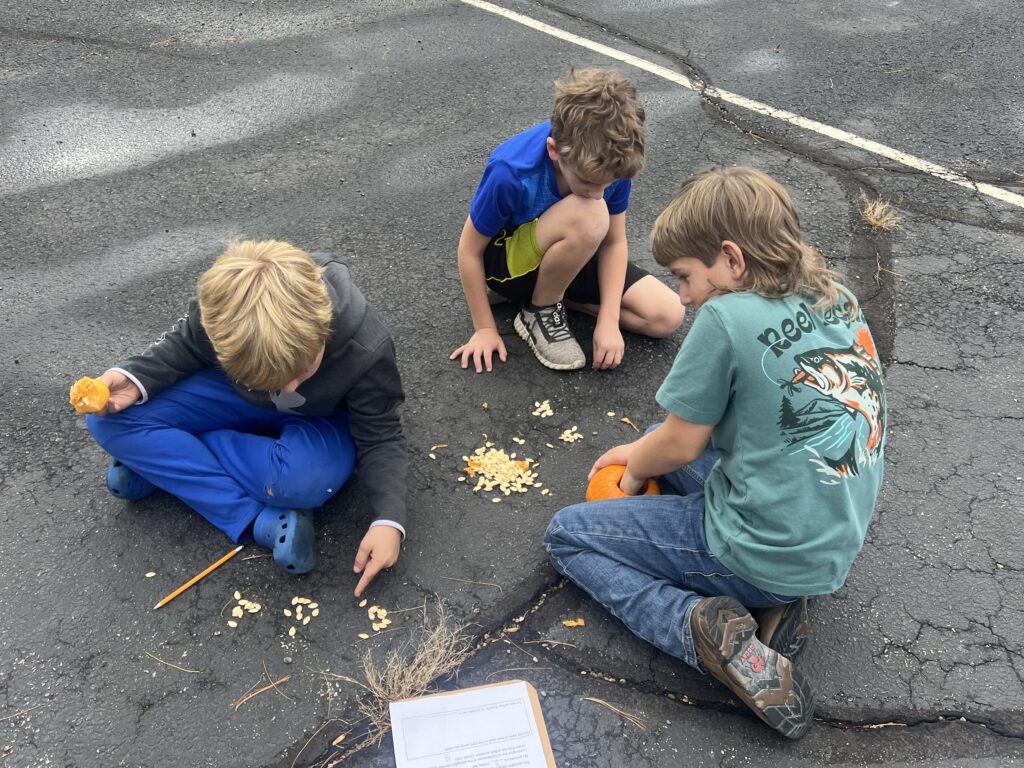





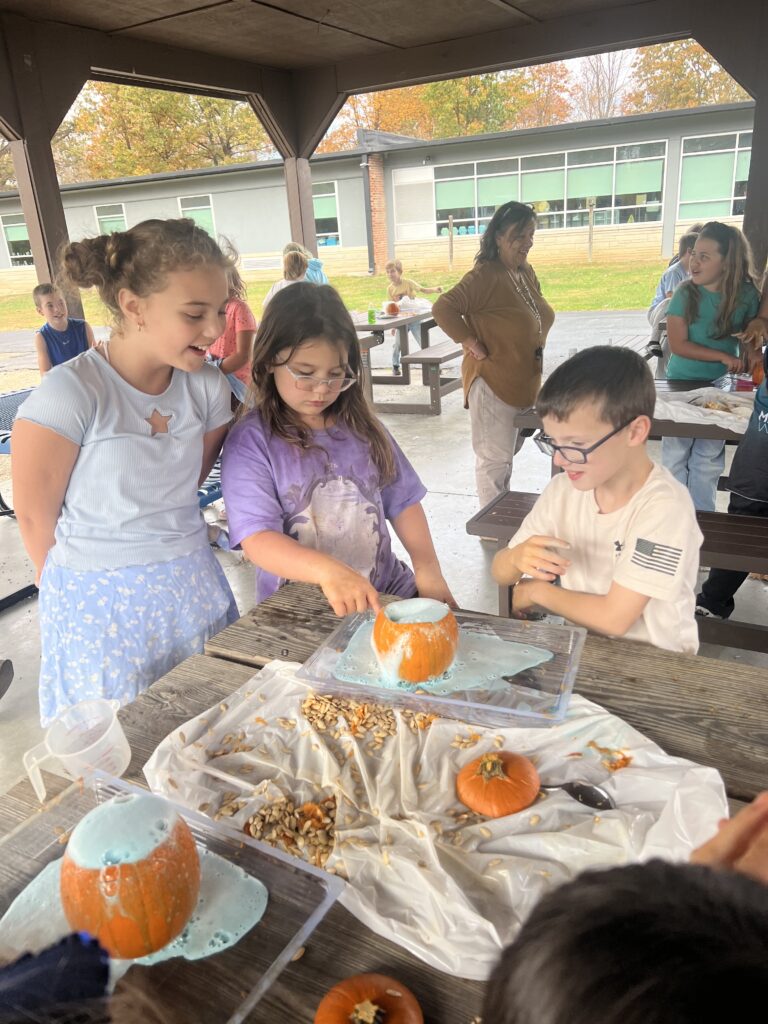
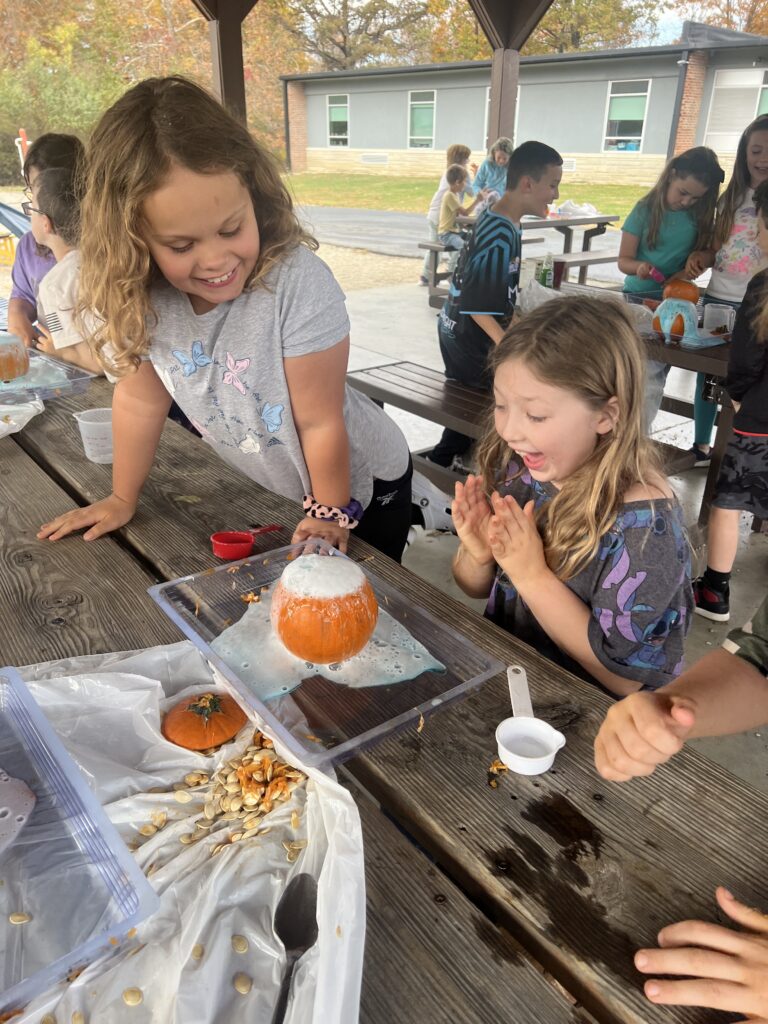



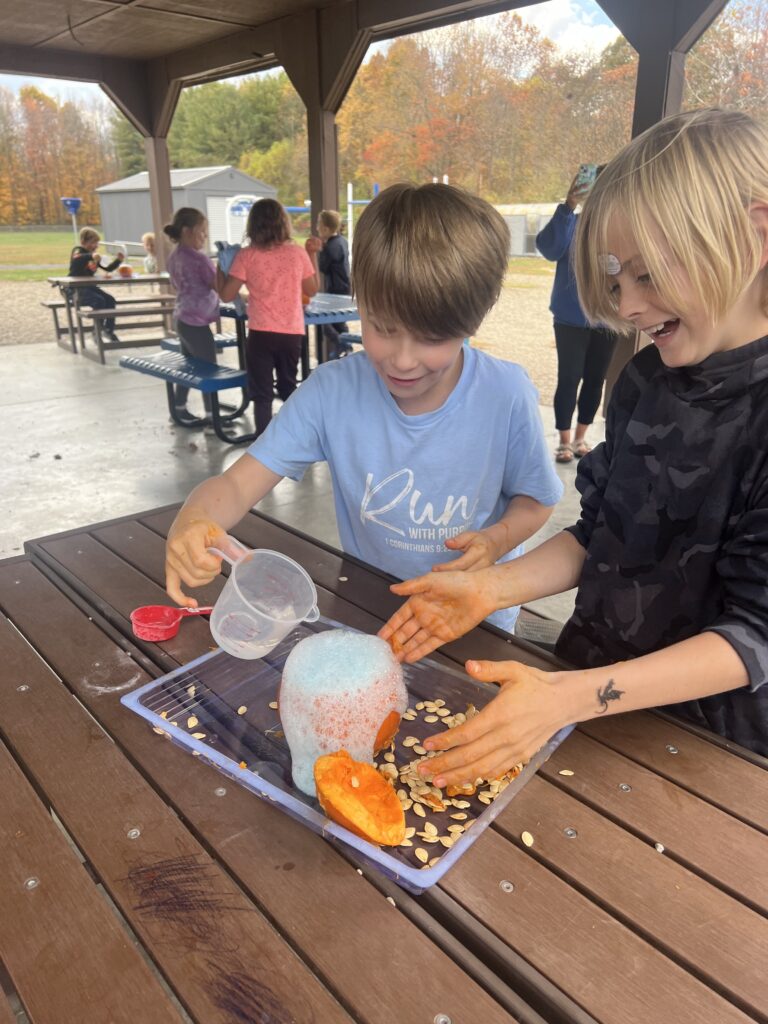


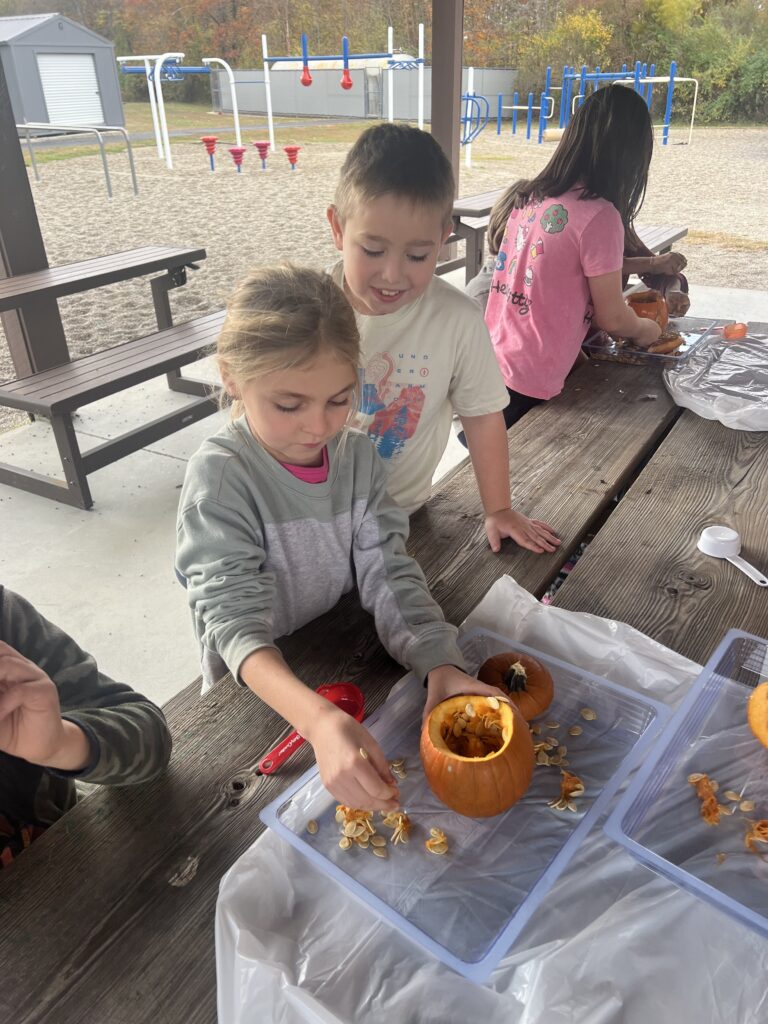





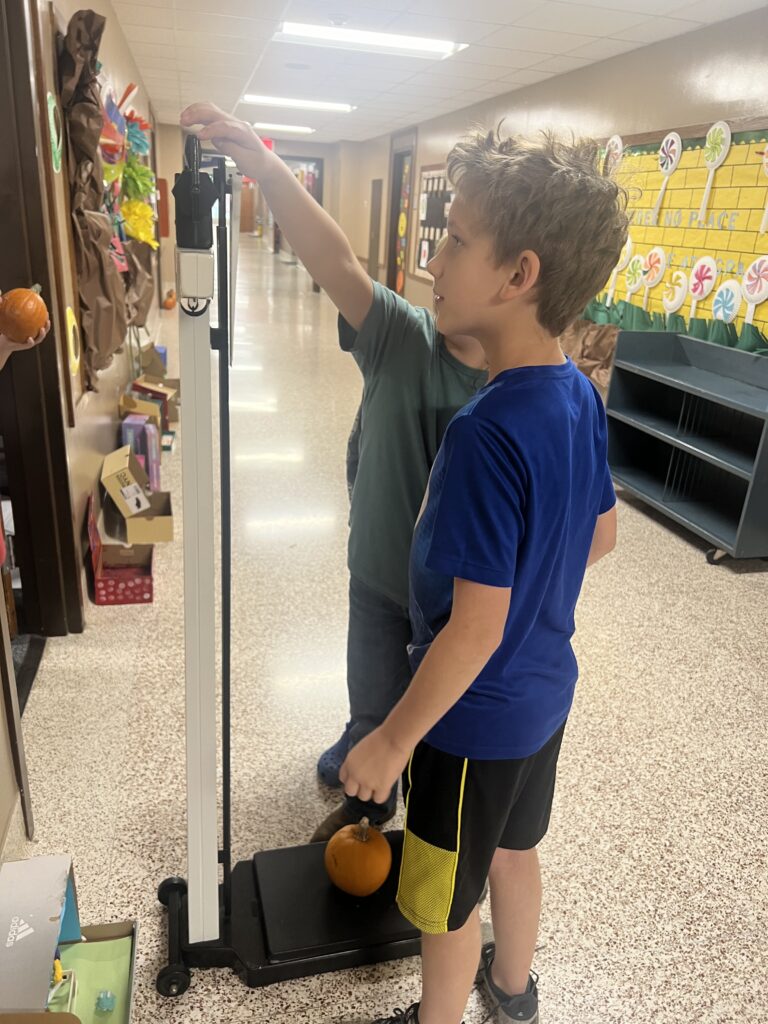


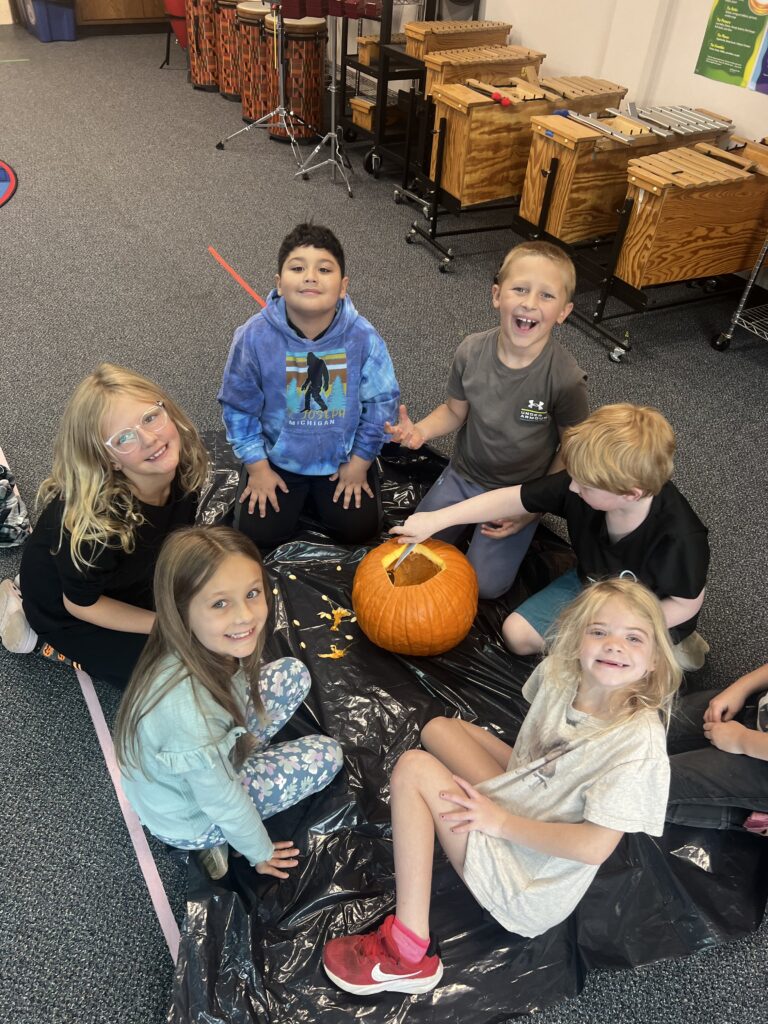

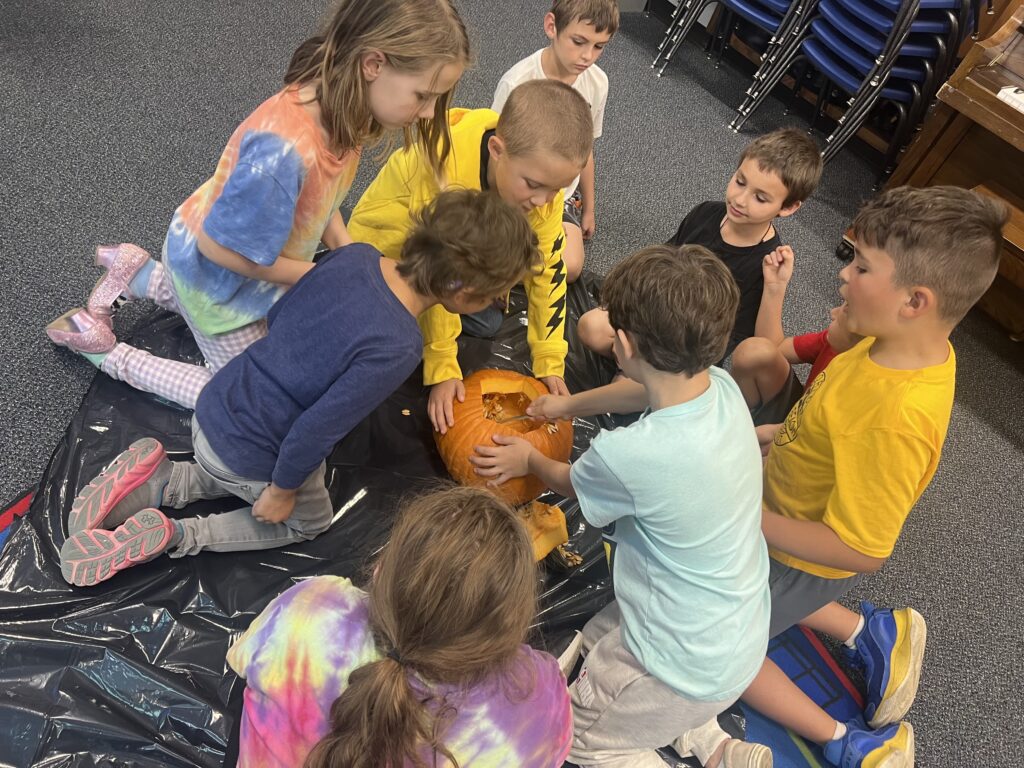
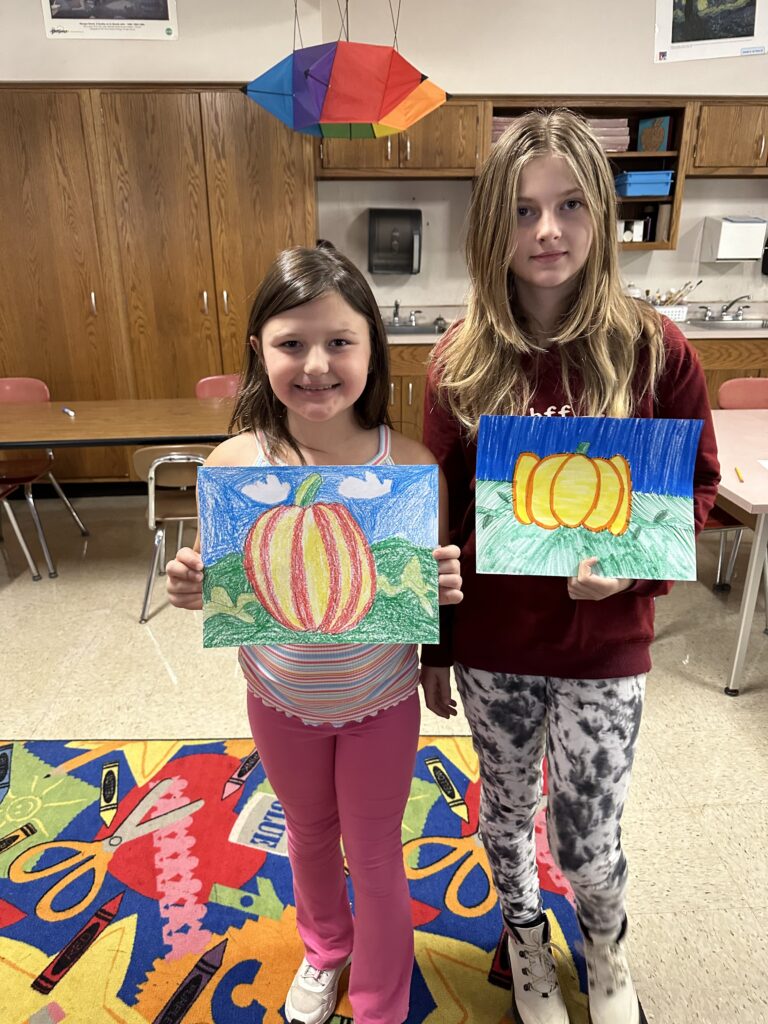

This week in science…
A BIG thank you to the Purdue Extension program for teaching all the classes about apples this week! The lesson included topics such as food waste, production, producers, consumers, healthy eating habits, and using our five senses. Third, fourth, and fifth grade students used the scientific method to determine which liquid prevents oxidation the best. Kindergarten, first, and second grade discussed pollination and the life cycle of apples including the difference between apple trees in the spring and apple trees in the fall. Of course, there was lots of apple tasting too! Students also made observations and then voted on their favorite apple based on taste and texture.










October 18, 2024
STEM Student of the Week: Eli Gordon

Fourth grade students began a new unit all about Animal and Plant Adaptations. In this unit, students explore the adaptations of animals and plants. Students investigate how the external and internal structures of an organism work together as an interconnected system that aid in their growth and survival. They also use models to explore how a combination of instincts and memories influence animal behavior.
Third grade students began a new unit called Stormy Skies. In this unit, students investigate and make predictions about the weather through careful observation of the clouds and wind. Students also learn to differentiate between weather and climate and use models to reveal global climate patterns.
Second grade students began a new unit called Work of Water. In this unit, students explore how water shapes the Earth’s surface. Students construct and use models of mountains to demonstrate that water flows downhill, and in the process, transforms huge rocks into the tiny grains of sand we find at the beach. Students also construct and use model hills to determine the causes of erosion, and to design solutions to problems caused by erosion.
First grade students carried out an investigation to determine the relationship between the shape of different bird beaks and the food each bird eats. In the activity, Find the Best Beak, students experimented with long pointy beaks that are great for picking up seeds and wide flat beaks that are good for scooping. They discovered that different beaks are best for different kinds of food.





October 4, 2024
STEM Student of the Week: Linda Gobert

This week in science…
Fifth grade students combined what they have learned about plants, animals, and decomposers to see how they interact in an ecosystem. In the activity, Pond Ecosystem Game, students first built a pond ecosystem that will support a sunfish. To succeed, they had to make sure that carbon dioxide levels are healthy for both plants and animals. Then, students played a game called Big Fish where they competed to make a healthy ecosystem for a sunfish.
Second grade students investigated which kinds of birds are likely to visit a bird feeder based on what they eat. In the activity, Design a Bird Feeder, students first drew their own bird feeder design to attract a specific type of bird. Then they built a prototype of their bird feeder using available materials.
First grade students carried out an investigation to determine the relationship between the shape of different bird beaks and the food each bird eats. In the activity, Find the Best Beak, students experimented with long pointy beaks that are great for picking up seeds and wide flat beaks that are good for scooping. They discovered that different beaks are best for different kinds of food.
Kindergarten students observed different animal behaviors and worked to discover another pattern: all animals seek safety in order to survive. The activity, Gopher in a Hole, included physical movements in which students pretended to be snails hiding in their shells, praying mantises scaring away predators, and gophers popping out of holes.





September 27, 2024
STEM Student of the Week: Elliott Williams

This week in Science…
Fifth grade students discovered the role fungi play in decomposing dead materials and in creating soil. In the activity, Mold Terrarium, students planned and conducted an investigation to discover the factors affecting decomposition. Students filled Ziploc bags with different types of foods and changed environmental conditions to study how different variables affect mold growth. They then observed mold growth over a period of two weeks.
Fourth grade students explored the brain’s role in receiving information from the senses, processing that information, and controlling the muscles to enable movement. In the activity, Think Fast!, students tested their reflexes with two very quick experiments and one more involved activity. They learned about how we process information in our brains and then respond to that information in different ways.
Third grade students learned about how fossil dinosaur tracks revealed how quickly a dinosaur was running. In the activity, Outrunning CeeLo, students figured out if they could have won a race with a dinosaur that was just their size. To determine the winner, students compared the length of their running steps with the dinosaur’s steps.
Second grade students learned about a case study in biodiversity using the frogs of North America. In the activity, Who’s Calling?, students learned to identify frogs by their unique calls and investigated which of two locations has a greater variety of frogs. After listening to recordings of frog calls, students created words that will remind them of the sounds, and then used those words to identify frog sounds in different environments.
First grade students made observations of baby animals and their parents, gathering evidence that they look similar because they share many of the same traits. In the activity, Baby Bird Rescue, students helped identify lost baby birds based on observations of their specific traits.
Kindergarten students participated in a Read-Along lesson. In the story, Sofia wonders where animals live and goes for a walk in the woods to find out. The lesson included a short exercise where students pretended to be squirrels and learned about their habitats.





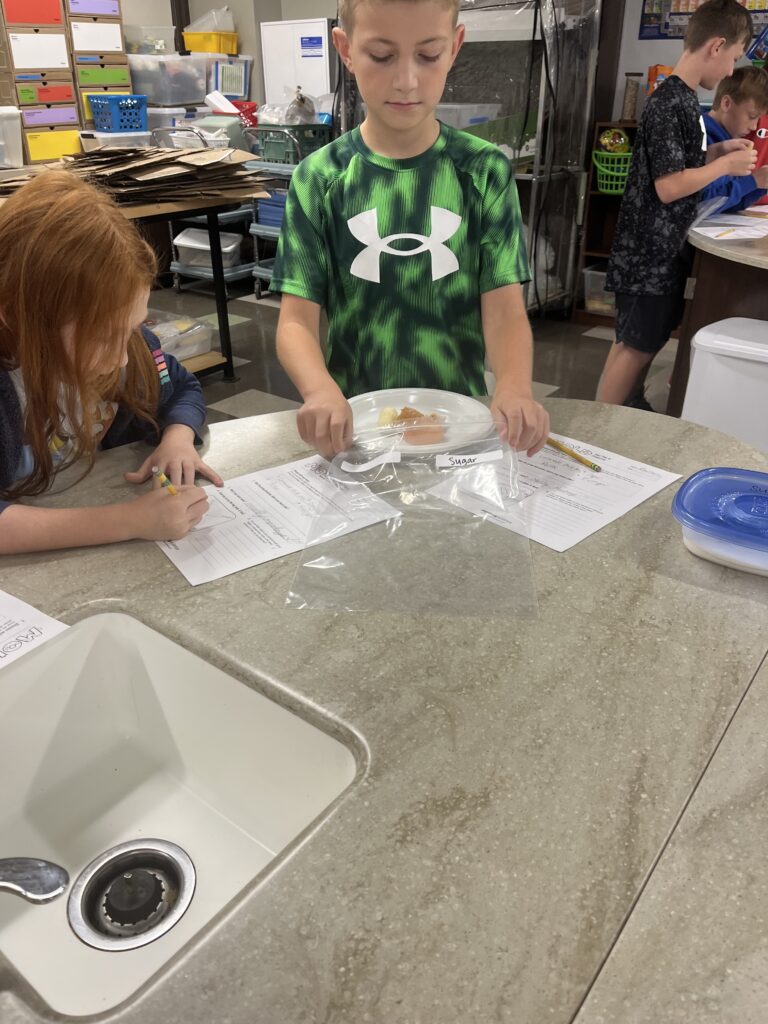




September 20, 2024
STEM Student of the Week: Aubree Priddy

This week in science…
Fifth grade students developed their thinking about the predator/prey relationships between living things. In the activity, Eat or Be Eaten, students played a card game in which they made food chains with predators and prey, and producers and consumers. The students who made the longest food chains won the game!
Fourth grade students delve further into the workings of the eye, exploring the function of their iris and pupil. In the activity, Pupil Card, students added a smaller pupil to the eye model that they created in the previous lesson. Then they observed how the changing size of the pupil controls how much light enters the eye.
Third grade students analyzed data from dinosaur fossils in order to provide evidence about the appearance and behavior of those dinosaurs when they were living. In the activity, Dinosaur Detectives, students compared the traits of dinosaur fossils with the traits of modern animals in order to help a paleoartist draw a dinosaur as accurately as possible.
Second grade students solved the mystery of why a group of wild bighorn sheep would leave their usual desert habitat to visit a second, very different habitat: a local playground. In the activity, Habitat Scavenger Hunt, students recorded observations of the diversity of life found in the desert and the playground, as well as the physical characteristics of each location. Students combined these observations to create an understanding of how the living and non-living parts of a habitat support the animals that live there.
First grade students made observations of baby animals and their parents, gathering evidence that they look similar because they share many of the same traits. In the activity, Baby Bird Rescue, students helped identify lost baby birds based on observations of their specific traits.
Kindergarten students observed animal behaviors and worked to discover a pattern: all animals seek food in order to survive. The activity, Eat Like an Animal, included physical movement in which students acted out animal behaviors, pretending to be quail scratching in the dirt, raccoons wading in the water, and woodpeckers pecking a log.





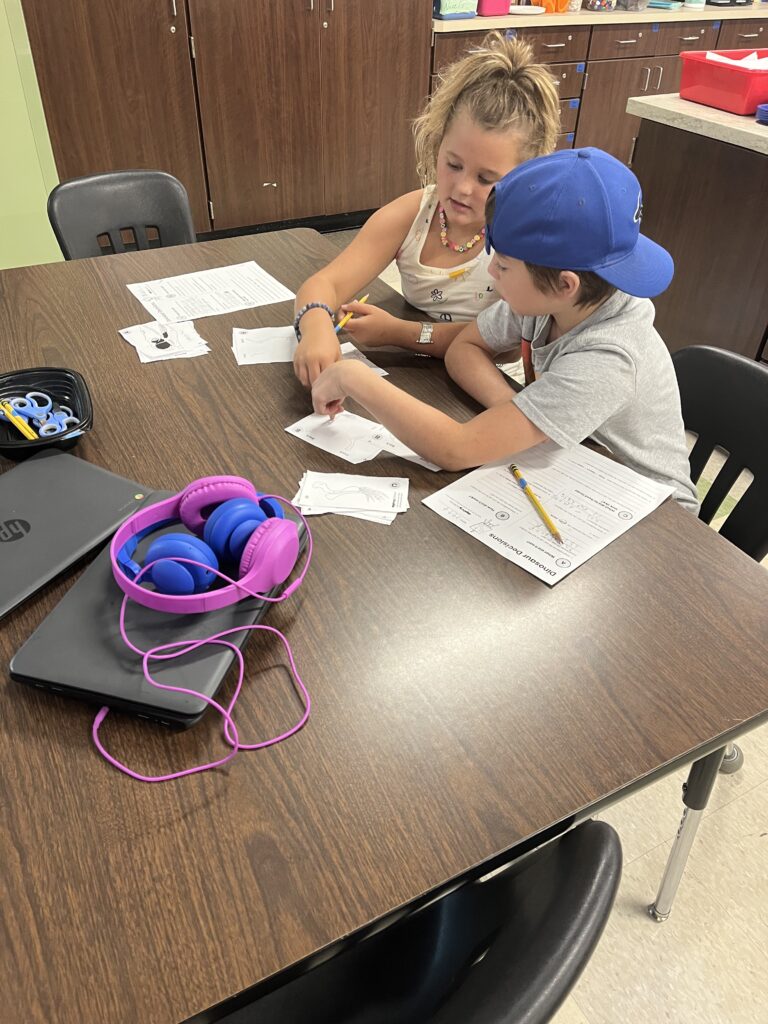

September 13, 2024
STEM Student of the Week: Willow Hardin

This week in science…
Fifth grade students began a new science unit called Web of Life. In this unit, students explore how organisms depend on one another and form an interconnected ecosystem. Students investigate food chains, food webs, and the importance of producers, consumers, and decomposers.
Fourth grade students began a new science unit called Human Machine. In this unit, students investigate structures and functions of the human body. Students explore how our bones and muscles are interconnected, how our eyes interact with light and impact our vision, and how our brain responds to stimuli in our environment.
Third Grade students began a new science unit called Animals Through Time. In this unit, students develop an understanding of how animals and their environments have changed through time. Fossils provide a window into the animals and habitats of the past. Analyzing the traits of animals that are alive today and comparing them to fossils, provides evidence of how these ancient organisms and environments of the past may have appeared.
Second grade students began a new science unit called Animal Adventures. In this unit, students begin to develop an understanding of the world’s animal biodiversity. They explore animal classification and the traits that define each group. Students then turn their focus to habitats and how the surrounding environment affects what organisms live in a particular environment.
First grade students began a new science unit called Animal Superpowers. In this unit, students explore how the external characteristics of animals are essential for their survival. Students also make observations of parents and their offspring, determining how they are similar and how their behaviors help offspring survive.
Kindergarten students began a new science unit called Animal Secrets. In this unit, students use observations to understand the basic needs of animals. Students explore how animals need things to eat and a safe place to live, and also how animals can change their environments to meet those needs.




September 6, 2024
STEM Student of the Week: Jaz-Leigh Davis

This week in science…
Fifth, fourth, and third grade continued learning about new science tools. They all learned how to use and read a triple beam balance scale. They weighed and recorded the mass of various objects from the science lab and compared their results with each other.
First and second grade made a Curiosity Wheel to take home and use whenever they are curious and have questions. They learned that asking questions helps scientists learn even more.
Hot and cold was the topic for kindergarten this week. Students listened to a story and then did and hot and cold sort.







August 30, 2024
This week in science…
Fourth and fifth graders learned all about our microscopes. They learned the history, how they work, and the different parts on the first day. The next 2 days were for looking at different slides and drawing and labeling what they saw.
Third grade started their week with another scientific method lab. This time they made predictions on how many drops of water they could fit on a penny, nickel, dime, and quarter. They recorded their data and averaged their results. They also came up with reasons why their results may be different than those at their table.
Kindergarten through second grade practiced with bucket balance scales. Kindergarten compared weights of objects while first and second grade counted how many cubes were equal to their objects.
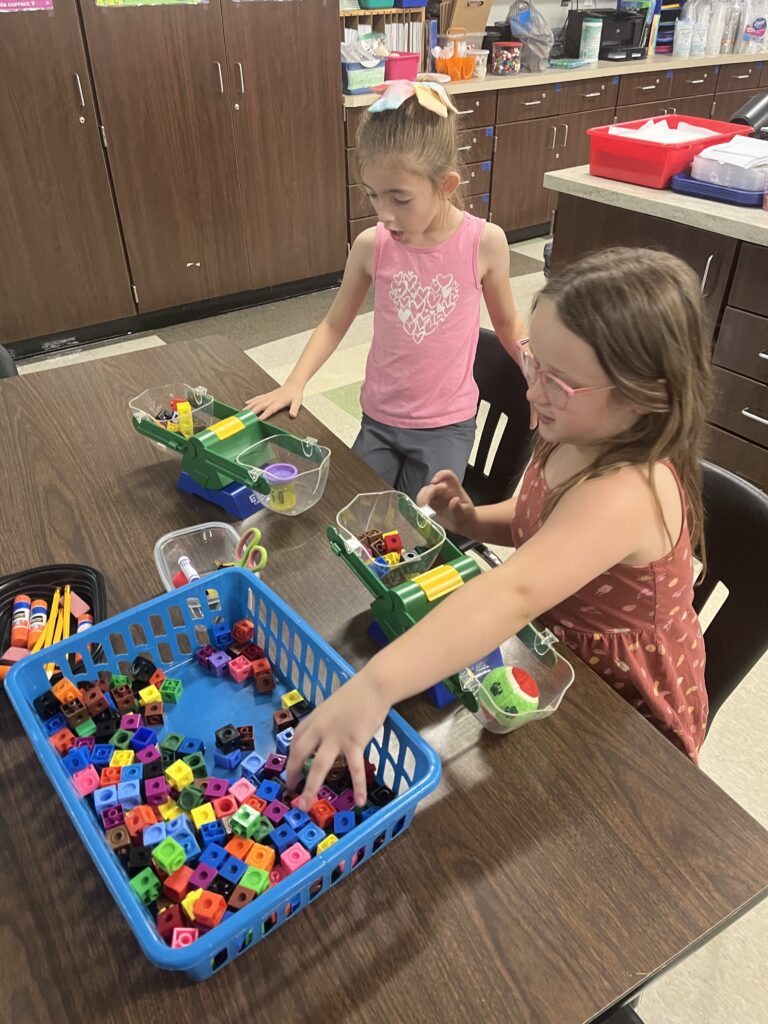











August 23, 2024
STEM Student of the Week: Axel Braunagel

This week in Science…
Students reviewed the steps of the scientific method and had their first investigation lab. Fifth grade students investigated what happens to gummy worms after they are left in liquid for 24 hours. Students chose between seven different liquids and formed a hypothesis based on research. They measured height, length, width, and mass before and after the worms and recorded their data, analyzed their results, and concluded if their hypothesis was correct or proven wrong.
Fourth and third grade students had a skittles lab! They predicted which color would be the most prevalent in their bag. They collected their data, graphed their results, and found their conclusion if they had predicted correctly or not. And of course they got to eat their skittles!





August 16, 2024
STEM Student of the Week: Norah Tiernan

This week in Science students reviewed the steps of the engineering design process with their first stem challenge of the school year. Students were given 12 index cards and 20 dot stickers. They had to work together to build the tallest tower in the time limit. We talked about the idea of a growth mindset and how important that is when completing stem challenges and persevering when something doesn’t go as planned. Students took what they learned the first time and completed the challenge again. They did a great job and there were some very creative designs!





